Hmm, what a funky word. Shmups. Not a lot of people like the term (short for shoot-’em-ups) but I tend to prefer it as “shooter” now seems to be used more for FPS games these days. I don’t pretend to be “hardcore” or any such nonsense; I just like the way it sounds. Shmups… kind of rolls off the tongue.
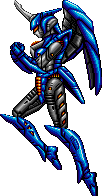 More than any other single word, I think it pretty much sums up perhaps the Genesis’ strongest genre. Cut through the waves of platformers, excellent sports titles, incredible action games, and you’ll find them. Tens of titles – vertical, horizontal, and beyond – all sharing a common theme: save the universe! Some do it better than others and some downright suck. You cannot, however, deny that the early ’90s was a shmupper’s paradise on the system and no other console of the time (save perhaps the PC-Engine) came close to matching the incredible library the Genesis was home to.
More than any other single word, I think it pretty much sums up perhaps the Genesis’ strongest genre. Cut through the waves of platformers, excellent sports titles, incredible action games, and you’ll find them. Tens of titles – vertical, horizontal, and beyond – all sharing a common theme: save the universe! Some do it better than others and some downright suck. You cannot, however, deny that the early ’90s was a shmupper’s paradise on the system and no other console of the time (save perhaps the PC-Engine) came close to matching the incredible library the Genesis was home to.
Far too many of the better ones were left behind in Japan (Eliminate Down, Panorama Cotton, Gleylancer) but most of them were localized, for better or for worse. Though there are over seventy games in the genre on the Genesis, a few rise above the rest of the pack and really show off what Sega’s 16-bit wonder could do. This makes it difficult to find a true “best shmup” among the lineup. I do think, however, that there are quite a few deserving of mention. With this article, Sega-16 hopes to provide a “definitive list,” or buyers guide, for every shmup available on the Genesis, Sega CD, and 32X, both domestic and import.
I would like to thank the now-defunct Starbase299 for some of the sprites. Once one of the best sites on the internet for information on shmups, it is now sadly gone. Sega-16 intends to honor and preserve what Ghostwalker created and will acknowledge all content used from his former site.
Now, on to the games!
Horizontal Shmups
Adventurous Boy
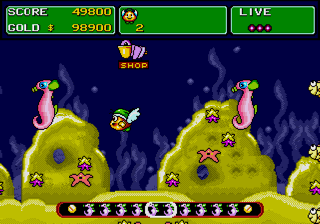 Chinese game developer Gametec was quite able at taking a formula and… how can I put this delicately… “emulating” it. Such is the case with Adventurous Boy, an unlicensed shooter that takes more than a casual inspiration from Sega’s classic Fantasy Zone franchise. Whether such work should be considered homage or straight up plagiarism is for the fans to decide, but in the end, Adventurous Boy is not actually all that exciting. Everything, and I do mean EVERYTHING is taken from Fantasy Zone, which is a pretty solid formula, so if you’re a fan of that series then you perhaps think that you’ll enjoy Gamtec’s version. That first impression is deceptive though. Sure, detailed and colorful visuals and “pick up and play” gameplay always go together like peanut butter and chocolate, so think of Adventurous Boy as the generic store brand to Sega’s Reece’s, right? Not quite. Countering the decent visuals is a soundtrack that’s grating, and some of the weapons are just ridiculously overpowered. The game is still playable, providing that you don’t die. Losing a life means losing all your power-ups and starting with some Gradius level pea shooter and speed. You can go from being the King of Space to watching a “game over” screen really fast after losing that first life.
Chinese game developer Gametec was quite able at taking a formula and… how can I put this delicately… “emulating” it. Such is the case with Adventurous Boy, an unlicensed shooter that takes more than a casual inspiration from Sega’s classic Fantasy Zone franchise. Whether such work should be considered homage or straight up plagiarism is for the fans to decide, but in the end, Adventurous Boy is not actually all that exciting. Everything, and I do mean EVERYTHING is taken from Fantasy Zone, which is a pretty solid formula, so if you’re a fan of that series then you perhaps think that you’ll enjoy Gamtec’s version. That first impression is deceptive though. Sure, detailed and colorful visuals and “pick up and play” gameplay always go together like peanut butter and chocolate, so think of Adventurous Boy as the generic store brand to Sega’s Reece’s, right? Not quite. Countering the decent visuals is a soundtrack that’s grating, and some of the weapons are just ridiculously overpowered. The game is still playable, providing that you don’t die. Losing a life means losing all your power-ups and starting with some Gradius level pea shooter and speed. You can go from being the King of Space to watching a “game over” screen really fast after losing that first life.
I don’t know if many gamers will find it worth the time to track down, as it’s kind of hard to find, and prices can get pretty high. Overall, perhaps what Adventurous Boy has most going for it is the fact that it’s a rare shmup and it’s not a bootleg. Hmm, maybe it would be better to just stick with Reece’s after all…
Air Buster
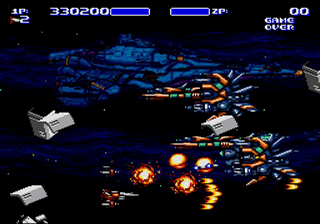 The first thing that comes to mind when I think of Air Buster is the special offer Kaneko had for it. If you bought the game, you could send off for an exclusive glove for your right hand! Tasteless jokes aside, Kaneko thought highly enough of their effort that they felt the blistering gameplay required protection for the player! I could not see myself wearing that glove, but I do have to agree that Air Buster is a great game. Huge, colorful stages and two-player cooperative mode bring a lot to the table, and the bosses are incredible. Perhaps my favorite part is having to fly through some narrow tunnels, Star Wars-style. Also released on the PC-Engine as Air Blasters, I’m unsure as to what the differences are between it and the Genesis and arcade versions. It’s hard to believe that this was one of the early third-party efforts on the Genesis (and by Kaneko, no less). The developer should have stayed away from fighting games and concentrated on shmups.
The first thing that comes to mind when I think of Air Buster is the special offer Kaneko had for it. If you bought the game, you could send off for an exclusive glove for your right hand! Tasteless jokes aside, Kaneko thought highly enough of their effort that they felt the blistering gameplay required protection for the player! I could not see myself wearing that glove, but I do have to agree that Air Buster is a great game. Huge, colorful stages and two-player cooperative mode bring a lot to the table, and the bosses are incredible. Perhaps my favorite part is having to fly through some narrow tunnels, Star Wars-style. Also released on the PC-Engine as Air Blasters, I’m unsure as to what the differences are between it and the Genesis and arcade versions. It’s hard to believe that this was one of the early third-party efforts on the Genesis (and by Kaneko, no less). The developer should have stayed away from fighting games and concentrated on shmups.
Android Assault
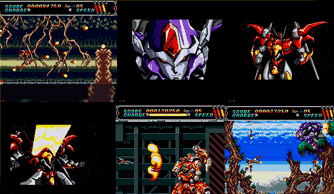 One of my favorite shmups on the Sega CD, Bari-Arm, or Android Assault as it’s called in the U.S., is a fine, fine game. The huge, multi-screen levels and crisp graphics look at home on Sega’s oft-neglected add-on, and the music is incredible. Throw in some huge bosses and the ability to transform your ship into a mech and you’ve got one of the more underrated shmups. It’s sad that this game can be had almost anywhere for peanuts and far too few people are even aware that it exists. Being a Sega CD fan myself, I can wholeheartedly recommend Android Assault for those who love blasting enemies in all sorts of environments (the waterfall level is gorgeous) as well as anyone looking for another title for their collection. It’s a great little game that is very easy to get into and is neither too short nor too long. Though the power ups are quite generic, the action is quick and smooth. If you’re looking for a great shmup for your Sega CD, look no further.
One of my favorite shmups on the Sega CD, Bari-Arm, or Android Assault as it’s called in the U.S., is a fine, fine game. The huge, multi-screen levels and crisp graphics look at home on Sega’s oft-neglected add-on, and the music is incredible. Throw in some huge bosses and the ability to transform your ship into a mech and you’ve got one of the more underrated shmups. It’s sad that this game can be had almost anywhere for peanuts and far too few people are even aware that it exists. Being a Sega CD fan myself, I can wholeheartedly recommend Android Assault for those who love blasting enemies in all sorts of environments (the waterfall level is gorgeous) as well as anyone looking for another title for their collection. It’s a great little game that is very easy to get into and is neither too short nor too long. Though the power ups are quite generic, the action is quick and smooth. If you’re looking for a great shmup for your Sega CD, look no further.
Arkagis Revolution
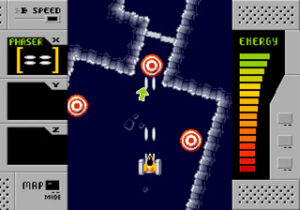 Another excellent aftermarket release, Arkagis Revolution is an impressive game that takes the Genesis hardware to places most people never thought it could reach by blending shooting and exploration with labyrinthine stages presented in Mode 7-style visuals. Players navigate by rotating the stage and shooting enemies while collecting power-ups, and the game offers convenient features like password saving accessible through the map and mid-stage checkpoints. The gameplay is fast-paced and responsive, and Mega Cat Studios upped the ante by including compatibility with various controllers, including the standard and six-button options, as well as the Sega Mouse and Sega Saturn keyboard. There’s simply nothing else like it on Genesis.
Another excellent aftermarket release, Arkagis Revolution is an impressive game that takes the Genesis hardware to places most people never thought it could reach by blending shooting and exploration with labyrinthine stages presented in Mode 7-style visuals. Players navigate by rotating the stage and shooting enemies while collecting power-ups, and the game offers convenient features like password saving accessible through the map and mid-stage checkpoints. The gameplay is fast-paced and responsive, and Mega Cat Studios upped the ante by including compatibility with various controllers, including the standard and six-button options, as well as the Sega Mouse and Sega Saturn keyboard. There’s simply nothing else like it on Genesis.
Arrow Flash
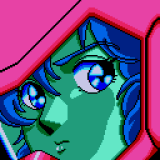 Renovation was very good to Genesis shmup fans, offering lots of games in the genre. Gaiares, Whip Rush, Vapor Trail, and Granada were some great games that are still a blast to play. Among this group was a little-known shmup called Arrow Flash. It came out very quietly in 1990 and was soon overshadowed by Gaiares and Thunder Force III. While not very original or innovative, Arrow Flash still has some merit and is worth tracking down. Decent graphics and great parallax, combined with some solid gameplay make for a decent time. They could have done more with the whole transformation feature (your ship can become a tiny mech) and the weapons were slightly underwhelming, but overall, the game is a decent play.
Renovation was very good to Genesis shmup fans, offering lots of games in the genre. Gaiares, Whip Rush, Vapor Trail, and Granada were some great games that are still a blast to play. Among this group was a little-known shmup called Arrow Flash. It came out very quietly in 1990 and was soon overshadowed by Gaiares and Thunder Force III. While not very original or innovative, Arrow Flash still has some merit and is worth tracking down. Decent graphics and great parallax, combined with some solid gameplay make for a decent time. They could have done more with the whole transformation feature (your ship can become a tiny mech) and the weapons were slightly underwhelming, but overall, the game is a decent play.
Atomic Robo-Kid
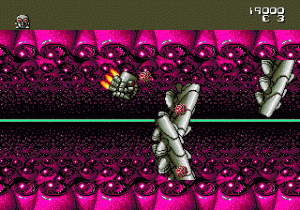 Perhaps one of the strangest shmups on any system, Atomic Robo-Kid appeared on the scene back in 1990 and was hardly even noticed. The now-defunct developer Treco introduced American audiences to the pudgy little hero, who looked more like a trash can with a hose glued to it than the savior of mankind. Not the most energetic of shmups, it can tend to get tedious after some time, since most of the levels look the same and there isn’t really anything going on to get you excited. The soundtrack is just as repetitive, and while the game isn’t bad, it’s not exceptionally good either. There are some interesting boss battles (the last guy is a bastard!), and the graphics are decent enough. The gameplay, however, is very middle-of-the-road and the levels are uninspired. Atomic Robo-Kid is an early effort by one of the first Genesis licensees, and it shows. Pick it up if you can find it cheap, or spring for the PC-Engine or C64 versions instead.
Perhaps one of the strangest shmups on any system, Atomic Robo-Kid appeared on the scene back in 1990 and was hardly even noticed. The now-defunct developer Treco introduced American audiences to the pudgy little hero, who looked more like a trash can with a hose glued to it than the savior of mankind. Not the most energetic of shmups, it can tend to get tedious after some time, since most of the levels look the same and there isn’t really anything going on to get you excited. The soundtrack is just as repetitive, and while the game isn’t bad, it’s not exceptionally good either. There are some interesting boss battles (the last guy is a bastard!), and the graphics are decent enough. The gameplay, however, is very middle-of-the-road and the levels are uninspired. Atomic Robo-Kid is an early effort by one of the first Genesis licensees, and it shows. Pick it up if you can find it cheap, or spring for the PC-Engine or C64 versions instead.
Bio-Hazard Battle
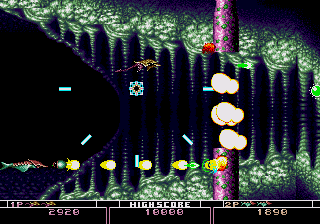 If you thought Insector X was the pinnacle of mutant bug shmupping, you were wrong. Bio-Hazard Battle takes things up a notch and is a solid outing that largely went unnoticed on the Genesis. That’s a shame, as the crisp, clear graphics and tight gameplay are more than worthy of your time. Some of the mutant creations you’ll face are downright weird-looking but I guess that’s what makes them mutants, right?
If you thought Insector X was the pinnacle of mutant bug shmupping, you were wrong. Bio-Hazard Battle takes things up a notch and is a solid outing that largely went unnoticed on the Genesis. That’s a shame, as the crisp, clear graphics and tight gameplay are more than worthy of your time. Some of the mutant creations you’ll face are downright weird-looking but I guess that’s what makes them mutants, right?
You can choose from four “ships,” each with a unique weapon. Options can be attained to assist you with a great eight-way missile attack or homing lasers. Regardless of which one you choose, the games remain more or less the same in terms of difficulty.
A semi-obscure title that can be had for beans, Bio-Hazard Battle comes highly recommended.
Bio-Ship Paladin
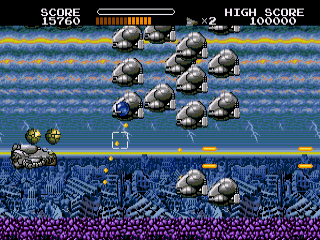 Every so often a shmup tries to break away from the standard game dynamics of its predecessors and be innovative. Bio-ship Paladin is one such game. As the name implies, your ship takes on new forms whenever you snatch a power up, and sort of evolves, much like Darwin 4081. The only problem with this is that it doesn’t translate to the gameplay as well as it should. You fire with the A button and use the B button to move around a cursor for a powerful attack. Your ship, being the slug that it is, cannot move when you use this weapon, essentially leaving making you a sitting duck. Switching between both armaments would be no problem were your ship’s default speed faster than a one-legged man without a cane. Almost as if the developers knew this, they implemented a life bar, and you’ll need it as you scramble around the screen trying to switch back and forth between the two guns. Good graphics and sound don’t go far enough to make up for this gameplay fumble. I guess the gameplay just didn’t evolve enough. The two-player simultaneous option is nice, but I can imagine the potential confusion as both players scramble to change weapons.
Every so often a shmup tries to break away from the standard game dynamics of its predecessors and be innovative. Bio-ship Paladin is one such game. As the name implies, your ship takes on new forms whenever you snatch a power up, and sort of evolves, much like Darwin 4081. The only problem with this is that it doesn’t translate to the gameplay as well as it should. You fire with the A button and use the B button to move around a cursor for a powerful attack. Your ship, being the slug that it is, cannot move when you use this weapon, essentially leaving making you a sitting duck. Switching between both armaments would be no problem were your ship’s default speed faster than a one-legged man without a cane. Almost as if the developers knew this, they implemented a life bar, and you’ll need it as you scramble around the screen trying to switch back and forth between the two guns. Good graphics and sound don’t go far enough to make up for this gameplay fumble. I guess the gameplay just didn’t evolve enough. The two-player simultaneous option is nice, but I can imagine the potential confusion as both players scramble to change weapons.
Curse
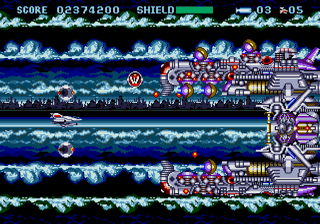 Curse has probably the most apt name of any video game I’ve ever played. It was slated for a U.S. release by INTV Corp. in 1990, but never arrived. It was instead left in Japan, where it quickly slid out of the public eye and into obscurity. Add to this the fact that other, more successful shmups like the almighty Thunder Force III were snapping up gamer’s shmupping dollars, and it’s no wonder that the game disappeared. Its worst enemy, however, has to be just how utterly average it is. Honestly, I’ve yet to play a Micronet game that didn’t make me yawn. Presentation is bare bones, and the gameplay is very cookie cutter. Subpar animation (what’s with the choppy scrolling?) and the dreaded “snail speed” your ship starts out with will make you reach for the power button. Not a bad shmup, but there’s just so much better on this list for you to spend your cash on.
Curse has probably the most apt name of any video game I’ve ever played. It was slated for a U.S. release by INTV Corp. in 1990, but never arrived. It was instead left in Japan, where it quickly slid out of the public eye and into obscurity. Add to this the fact that other, more successful shmups like the almighty Thunder Force III were snapping up gamer’s shmupping dollars, and it’s no wonder that the game disappeared. Its worst enemy, however, has to be just how utterly average it is. Honestly, I’ve yet to play a Micronet game that didn’t make me yawn. Presentation is bare bones, and the gameplay is very cookie cutter. Subpar animation (what’s with the choppy scrolling?) and the dreaded “snail speed” your ship starts out with will make you reach for the power button. Not a bad shmup, but there’s just so much better on this list for you to spend your cash on.
Eliminate Down
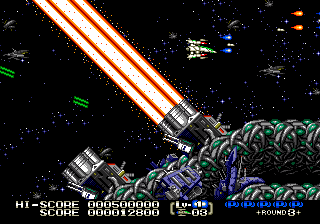 Another quality game that was never localized, Eliminate Down can honestly be ranked among the best 16-bit shmups of all time. One of what I like to call the “Forgotten Five” (along with Battlemania 2, Gleylancer, Panorama Cotton, and Undead Line), it truly sits at the top of the mountain. With a play style similar to R-Type and featuring some spectacular parallax scrolling, I’m amazed someone didn’t pick this up during the heyday of Genesis shmups. The graphics are great and the music rocks like a shmup soundtrack should. Moreover, the weapons system is highly intuitive and allows you to adjust on the fly, giving the impression that the game is easy, which it is not. The whole package is digital candy. Its rarity has made it one of the more expensive Mega Drive games out there but if you’re lucky enough to score a copy, get it! If there’s a downside, it’s the overall lack of a story. However, when did this ever really pose a problem in this genre? Shmups are about twitch gameplay and blowing stuff up and that is something that Eliminate Down has in spades.
Another quality game that was never localized, Eliminate Down can honestly be ranked among the best 16-bit shmups of all time. One of what I like to call the “Forgotten Five” (along with Battlemania 2, Gleylancer, Panorama Cotton, and Undead Line), it truly sits at the top of the mountain. With a play style similar to R-Type and featuring some spectacular parallax scrolling, I’m amazed someone didn’t pick this up during the heyday of Genesis shmups. The graphics are great and the music rocks like a shmup soundtrack should. Moreover, the weapons system is highly intuitive and allows you to adjust on the fly, giving the impression that the game is easy, which it is not. The whole package is digital candy. Its rarity has made it one of the more expensive Mega Drive games out there but if you’re lucky enough to score a copy, get it! If there’s a downside, it’s the overall lack of a story. However, when did this ever really pose a problem in this genre? Shmups are about twitch gameplay and blowing stuff up and that is something that Eliminate Down has in spades.
Fire Mustang
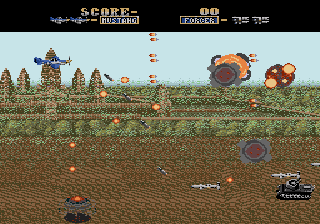 If you’re a fan of the 1941 games, then this is the shmup for you. It’s got all the fun and action of Capcom’s classic series, only from a horizontal perspective. It’s nice to see a Taito shmup here that isn’t part of the Darius series, and since WWII games are not a big part of the genre overall, Fire Mustang helps fit that particular niche. It’s a competent game in its own right and does a good job of conveying the feel of what the 1941 series might be like using this perspective, were that to ever happen. Funny how Capcom never tried that, given their experimentation with many of their franchises (Mega Man, Street Fighter, Ghosts ‘N Goblins). The only problem with Fire Mustang is that it’s only competent. Nothing really stands out, and while the action is enough to keep you interested, it won’t keep you coming back after the first play through. Decent graphics are overshadowed by a generic power up system, and even the boss battles are mediocre. Not a bad game by any means, but certainly not the best.
If you’re a fan of the 1941 games, then this is the shmup for you. It’s got all the fun and action of Capcom’s classic series, only from a horizontal perspective. It’s nice to see a Taito shmup here that isn’t part of the Darius series, and since WWII games are not a big part of the genre overall, Fire Mustang helps fit that particular niche. It’s a competent game in its own right and does a good job of conveying the feel of what the 1941 series might be like using this perspective, were that to ever happen. Funny how Capcom never tried that, given their experimentation with many of their franchises (Mega Man, Street Fighter, Ghosts ‘N Goblins). The only problem with Fire Mustang is that it’s only competent. Nothing really stands out, and while the action is enough to keep you interested, it won’t keep you coming back after the first play through. Decent graphics are overshadowed by a generic power up system, and even the boss battles are mediocre. Not a bad game by any means, but certainly not the best.
Gadget Twins
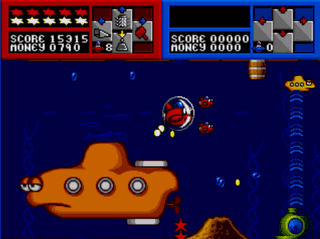 Imagine my surprise when I discovered that this game was actually a shmup. I had long believed it to be an infantile platformer and dismissed it without ever giving it a chance (big boo-boo, I know). Some time ago, I decided to finally try it out, and while it’s nowhere’s near classics like Thunder Force and M.U.S.H.A., it’s not as bad as you might think by looking at this screen shot. The graphics, all colorful and bright, are very cartoony and detailed, and parallax abounds. I did find the main attack to be quite awkward, as your ship launches a little spring boxing glove with which it smacks oncoming foes and opens treasure chests for goodies. One button changes its direction and the other actually attacks, and this can be a problem when more than a few enemies assault you at once. Aside from this, Gadget Twins is probably worth picking up and giving a few walkthroughs. It’s not the hottest thing around, but it’s far from the worst.
Imagine my surprise when I discovered that this game was actually a shmup. I had long believed it to be an infantile platformer and dismissed it without ever giving it a chance (big boo-boo, I know). Some time ago, I decided to finally try it out, and while it’s nowhere’s near classics like Thunder Force and M.U.S.H.A., it’s not as bad as you might think by looking at this screen shot. The graphics, all colorful and bright, are very cartoony and detailed, and parallax abounds. I did find the main attack to be quite awkward, as your ship launches a little spring boxing glove with which it smacks oncoming foes and opens treasure chests for goodies. One button changes its direction and the other actually attacks, and this can be a problem when more than a few enemies assault you at once. Aside from this, Gadget Twins is probably worth picking up and giving a few walkthroughs. It’s not the hottest thing around, but it’s far from the worst.
Gaiares
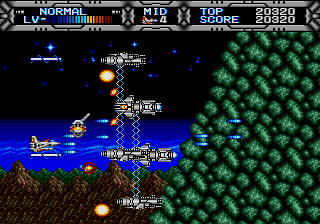 Here’s a title that attracts controversy. A classic to some, an overrated, mediocre effort to others, Gaiares is a game that commands attention. Brought over by Telenet (Renovation in the U.S.), it caught on with many gamers and quickly garnered a following. Big bosses and an innovative power up system (you latched your TOZ system onto enemies to steal their weapons) came wrapped in some great graphics and an excellent soundtrack. There was also a deep plot (well, deep for a shmup anyway) that was developed through some great-looking cut scenes (remember Valis III?). The game received many accolades from most of the gaming publications of the time, especially GamePro, and even won a few awards. I really enjoyed it, although the difficulty level was a bit off-putting at the beginning. The game is solid and highly replayable and should definitely be in your library.
Here’s a title that attracts controversy. A classic to some, an overrated, mediocre effort to others, Gaiares is a game that commands attention. Brought over by Telenet (Renovation in the U.S.), it caught on with many gamers and quickly garnered a following. Big bosses and an innovative power up system (you latched your TOZ system onto enemies to steal their weapons) came wrapped in some great graphics and an excellent soundtrack. There was also a deep plot (well, deep for a shmup anyway) that was developed through some great-looking cut scenes (remember Valis III?). The game received many accolades from most of the gaming publications of the time, especially GamePro, and even won a few awards. I really enjoyed it, although the difficulty level was a bit off-putting at the beginning. The game is solid and highly replayable and should definitely be in your library.
Gleylancer
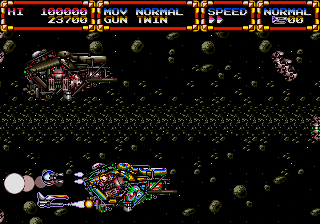 Most famous for its Engrish title translation, Gleylancer is perhaps one of the best 16-bit shmups ever made. As the pilot of an experimental fighter craft, you can end the war that rages between two massive star fleets. You might also find out what happened to your missing father in the process. Gleylancer is the second of the “Forgotten Five” I mentioned earlier here, and it is definitely worth your import dollar. Tons of parallax, an actual plot, and tons of terrific action are all part and parcel of this little gem. Gleylancer was published by NCS, the same people responsible for the incredible Target Earth, and that same great style shines through here. The opening story cinema is fantastic, and the entire presentation is second only to Gaiares in quality. An excellent weapons system and some great boss battles complete what is a must-have shmup. This is the type of game that makes you wonder why we got such turds like Twin Cobra when quality like this was waiting for release in the U.S.
Most famous for its Engrish title translation, Gleylancer is perhaps one of the best 16-bit shmups ever made. As the pilot of an experimental fighter craft, you can end the war that rages between two massive star fleets. You might also find out what happened to your missing father in the process. Gleylancer is the second of the “Forgotten Five” I mentioned earlier here, and it is definitely worth your import dollar. Tons of parallax, an actual plot, and tons of terrific action are all part and parcel of this little gem. Gleylancer was published by NCS, the same people responsible for the incredible Target Earth, and that same great style shines through here. The opening story cinema is fantastic, and the entire presentation is second only to Gaiares in quality. An excellent weapons system and some great boss battles complete what is a must-have shmup. This is the type of game that makes you wonder why we got such turds like Twin Cobra when quality like this was waiting for release in the U.S.
Heavy Unit
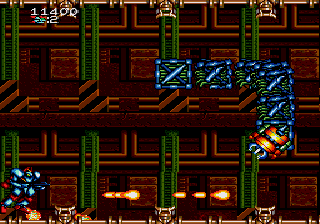 Heavy Unit is a port of the Japanese arcade game, and new levels were added for the home version. This is nice, and the gameplay, while reminiscent of Gradius with its simultaneous shot/bomb set up, is hampered a bit by a slow default speed and your foes’ blatant disregard for solid objects. Yes, while you can blow up instantly from scraping a wall (and you will), everything else can phase right through rock, stone, and metal! This takes some getting used to, to say the least, and can be problematic when more than one foe decides to pull this stunt at the same time. Once past this, however, Heavy Unit is a great shmup. I love the ability to transform into a robot (reminds me of Side Arms), and the graphics are great for such an early game. It even has a password feature! I suspect that Heavy Unit was left in Japan due to the glut of shmups that hit the Genesis between 1990 and 1991, and that’s too bad. It’s a solid game that’s actually better than some of the shmups that made it stateside during the time. Luckily, an import copy won’t run you too much.
Heavy Unit is a port of the Japanese arcade game, and new levels were added for the home version. This is nice, and the gameplay, while reminiscent of Gradius with its simultaneous shot/bomb set up, is hampered a bit by a slow default speed and your foes’ blatant disregard for solid objects. Yes, while you can blow up instantly from scraping a wall (and you will), everything else can phase right through rock, stone, and metal! This takes some getting used to, to say the least, and can be problematic when more than one foe decides to pull this stunt at the same time. Once past this, however, Heavy Unit is a great shmup. I love the ability to transform into a robot (reminds me of Side Arms), and the graphics are great for such an early game. It even has a password feature! I suspect that Heavy Unit was left in Japan due to the glut of shmups that hit the Genesis between 1990 and 1991, and that’s too bad. It’s a solid game that’s actually better than some of the shmups that made it stateside during the time. Luckily, an import copy won’t run you too much.
Hellfire
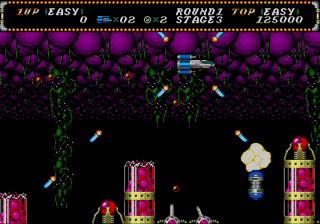 Even after all these years, I still find it humorously ironic just how well the title Hellfire fits this game. Harder than most shmups, Hellfire is a great game nonetheless, and though some argue that the PC-Engine version is superior, I prefer the Genesis port. Sure, the graphics aren’t as crisp or detailed as the arcade original and the music might not be as good as it is on PCE. What is the same is the insane difficulty level and the Gradius-style gameplay. As one of only four games released by publisher Seismic (they also gave us the godly M.U.S.H.A.) Hellfire is hard enough to make even the most confident of shmuppers cry like a little girl. What’s that? You lost your über powered up ship on level three? Better start over friend, because your little pea shooter is hardly a match for what’s in store. You could also break out that Game Genie, but that wouldn’t make you “hardcore,” now, would it? I, for one, prefer my wits and a healthy blood pressure level to being “hardcore” so my Game Genie is already waiting.
Even after all these years, I still find it humorously ironic just how well the title Hellfire fits this game. Harder than most shmups, Hellfire is a great game nonetheless, and though some argue that the PC-Engine version is superior, I prefer the Genesis port. Sure, the graphics aren’t as crisp or detailed as the arcade original and the music might not be as good as it is on PCE. What is the same is the insane difficulty level and the Gradius-style gameplay. As one of only four games released by publisher Seismic (they also gave us the godly M.U.S.H.A.) Hellfire is hard enough to make even the most confident of shmuppers cry like a little girl. What’s that? You lost your über powered up ship on level three? Better start over friend, because your little pea shooter is hardly a match for what’s in store. You could also break out that Game Genie, but that wouldn’t make you “hardcore,” now, would it? I, for one, prefer my wits and a healthy blood pressure level to being “hardcore” so my Game Genie is already waiting.
Insector X
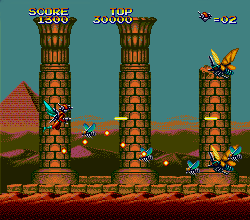 What happened here? After playing the great arcade version of this, I was expecting something more or less along the same lines, given the Genesis’ ability to produce accurate ports of arcade shmups at the time. This is simply not what I expected. Boring, slow-paced gameplay that goes NOWHERE, and some of the blandest graphics on the system. Where the hell did all the parallax go? There isn’t a single line here. Nothing. Zip. Zilch. Nada. Even worse, the character sprites are watered down from the original, and even your craft looks like crap. Shouldn’t a shmup about bugs have some big, ugly, mean-looking bugs? What we have here looks more like an episode of Miss Spider’s Sunny Patch Kids with guns. This is not the way to do an arcade shmup justice, and even Sage’s Creation should be above such a bad port. If you simply must have every shmup available for the Genesis, then by all means, pick up a copy. Everyone else should use their money for something decent.
What happened here? After playing the great arcade version of this, I was expecting something more or less along the same lines, given the Genesis’ ability to produce accurate ports of arcade shmups at the time. This is simply not what I expected. Boring, slow-paced gameplay that goes NOWHERE, and some of the blandest graphics on the system. Where the hell did all the parallax go? There isn’t a single line here. Nothing. Zip. Zilch. Nada. Even worse, the character sprites are watered down from the original, and even your craft looks like crap. Shouldn’t a shmup about bugs have some big, ugly, mean-looking bugs? What we have here looks more like an episode of Miss Spider’s Sunny Patch Kids with guns. This is not the way to do an arcade shmup justice, and even Sage’s Creation should be above such a bad port. If you simply must have every shmup available for the Genesis, then by all means, pick up a copy. Everyone else should use their money for something decent.
Keio Flying Squadron
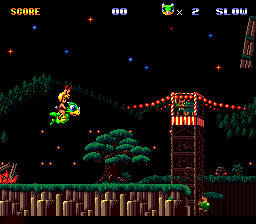 Anyone who can’t find something good in a game about a girl in a bunny suit who rides a dragon into battle needs to be medicated. Certainly not the deepest shmup ever made but by far one of the weirdest, Keio Flying Squadron tells the tale of Rami, a young girl who must retrieve the key to the powerful ark from the nefarious Dr. Pon. Hey, I said it was weird, didn’t I? That’s the whole charm of this game, essentially. The off-the-wall humor and wacky enemies are almost a parody of the genre. It never takes itself too seriously, even during boss battles (those with a raccoon phobia need not apply, as the little critters are everywhere!). It’s not exactly the most complex shooter out there. The weapon system is ho-hum, the music is decent (and red book!), and the graphics are good but nothing spectacular. Even so, you need this game in your collection. Where it really shines is in the cut scenes. Beat a stage and you’re rewarded with some cinema scenes that further the story along. I found myself playing just to see what would happen next. It’s truly amazing that JVC took a chance on this and localized it. I’m sure it probably tanked in sales. It has become something of a cult classic (complete copies are currently going for upwards of $75 on eBay), as more and more gamers discover this little gem for their Sega CD. HYPER CUTIE FIGHTING SHAPE!
Anyone who can’t find something good in a game about a girl in a bunny suit who rides a dragon into battle needs to be medicated. Certainly not the deepest shmup ever made but by far one of the weirdest, Keio Flying Squadron tells the tale of Rami, a young girl who must retrieve the key to the powerful ark from the nefarious Dr. Pon. Hey, I said it was weird, didn’t I? That’s the whole charm of this game, essentially. The off-the-wall humor and wacky enemies are almost a parody of the genre. It never takes itself too seriously, even during boss battles (those with a raccoon phobia need not apply, as the little critters are everywhere!). It’s not exactly the most complex shooter out there. The weapon system is ho-hum, the music is decent (and red book!), and the graphics are good but nothing spectacular. Even so, you need this game in your collection. Where it really shines is in the cut scenes. Beat a stage and you’re rewarded with some cinema scenes that further the story along. I found myself playing just to see what would happen next. It’s truly amazing that JVC took a chance on this and localized it. I’m sure it probably tanked in sales. It has become something of a cult classic (complete copies are currently going for upwards of $75 on eBay), as more and more gamers discover this little gem for their Sega CD. HYPER CUTIE FIGHTING SHAPE!
Lords of Thunder
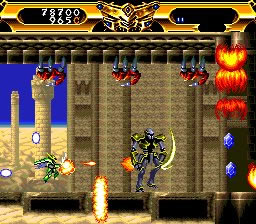 Not as pretty as the Turbo Duo version and suffering from a smaller color palette, the Sega CD release of Lords of Thunder also has a remixed soundtrack. Why this was done is beyond me, and it makes little sense. The original soundtrack was perfect. Questionable changes notwithstanding, it’s still a great game that all Sega CD owners need to play. There are plenty of stages, power ups galore, and a decent challenge level. The intro now has voice narration, and the ending is excellent. The boss battles have ramped up and these master baddies now take more hits than ever to dispatch. I find myself going back to this one a few times a year, as the remixed soundtrack still rocks, just not as hard as its Duo cousin. The gameplay is tight and the shop concept (think Forgotten Worlds) is something I would like to see more games in the genre embrace. Collecting money from fallen foes to buy new weapons makes more sense than these suicide power up capsules that just run out into a firefight to die.
Not as pretty as the Turbo Duo version and suffering from a smaller color palette, the Sega CD release of Lords of Thunder also has a remixed soundtrack. Why this was done is beyond me, and it makes little sense. The original soundtrack was perfect. Questionable changes notwithstanding, it’s still a great game that all Sega CD owners need to play. There are plenty of stages, power ups galore, and a decent challenge level. The intro now has voice narration, and the ending is excellent. The boss battles have ramped up and these master baddies now take more hits than ever to dispatch. I find myself going back to this one a few times a year, as the remixed soundtrack still rocks, just not as hard as its Duo cousin. The gameplay is tight and the shop concept (think Forgotten Worlds) is something I would like to see more games in the genre embrace. Collecting money from fallen foes to buy new weapons makes more sense than these suicide power up capsules that just run out into a firefight to die.
It may not be the best version of the game out there but it’s undoubtedly the cheapest and easiest to come by. Check out our Side-by-Side feature comparing it to the Super CD-ROM version.
Sagaia
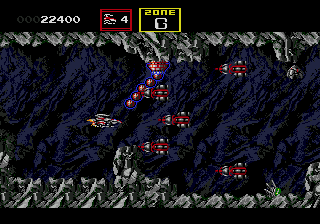 The only Darius game to appear on the Genesis, Sagaia (Darius 2 in Japan) may have been affected by the name change. I’m sure that more gamers would have taken notice of it had it arrived bearing its famous moniker. Even with the new title, it still has all the great elements that make the Darius series such a fan favorite. Shooting at flying fish is strangely fun, which sounds odder than it actually is. Darius Twin on the SNES may be more colorful (as are a lot of SNES ports), and Darius 2 on the PC-Engine CD may have a better soundtrack, but Taito’s port holds its own on the Genesis. Being able to play with a friend at the same time adds a great deal to the gameplay, though some flicker can get in the way sometimes. No Genesis shmup fan should be without Sagaia, if at least to represent the series, which is something this game does very well.
The only Darius game to appear on the Genesis, Sagaia (Darius 2 in Japan) may have been affected by the name change. I’m sure that more gamers would have taken notice of it had it arrived bearing its famous moniker. Even with the new title, it still has all the great elements that make the Darius series such a fan favorite. Shooting at flying fish is strangely fun, which sounds odder than it actually is. Darius Twin on the SNES may be more colorful (as are a lot of SNES ports), and Darius 2 on the PC-Engine CD may have a better soundtrack, but Taito’s port holds its own on the Genesis. Being able to play with a friend at the same time adds a great deal to the gameplay, though some flicker can get in the way sometimes. No Genesis shmup fan should be without Sagaia, if at least to represent the series, which is something this game does very well.
Sol-Feace
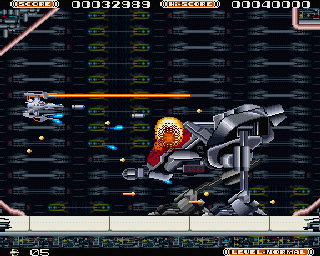 I think it’s safe to include both the Genesis and Sega CD versions of this game here. Be it Sol-Feace or Sol-Deace, both are pretty run-of-the-mill. I get the impression that Wolf Team was striving for a Gate of Thunder feel here, and they kind of came up short. I’m not saying that either Sol is bad (I prefer the Sega CD version myself for its cut scenes and music), but the TG-CDROM’s killer app just trounces them. The biggest problem here is that everything is so slow. While shmups shouldn’t zip along at the speed of light, they shouldn’t be driving Miss Daisy either. You basically plod along through each stage, until you finally come to a boss, which is usually unspectacular too. There’s also some nasty flicker that can occasionally get in the way of oncoming bullets, which is never a good thing. Aside from these two problems, the game isn’t bad at all. As I mentioned above, the Sega CD version is the way to go, with its story enhancements and great music. I especially liked the patented Wolf Team maraca sound (wouldn’t be a WF game without it!) and the cool multi-jointed foes.
I think it’s safe to include both the Genesis and Sega CD versions of this game here. Be it Sol-Feace or Sol-Deace, both are pretty run-of-the-mill. I get the impression that Wolf Team was striving for a Gate of Thunder feel here, and they kind of came up short. I’m not saying that either Sol is bad (I prefer the Sega CD version myself for its cut scenes and music), but the TG-CDROM’s killer app just trounces them. The biggest problem here is that everything is so slow. While shmups shouldn’t zip along at the speed of light, they shouldn’t be driving Miss Daisy either. You basically plod along through each stage, until you finally come to a boss, which is usually unspectacular too. There’s also some nasty flicker that can occasionally get in the way of oncoming bullets, which is never a good thing. Aside from these two problems, the game isn’t bad at all. As I mentioned above, the Sega CD version is the way to go, with its story enhancements and great music. I especially liked the patented Wolf Team maraca sound (wouldn’t be a WF game without it!) and the cool multi-jointed foes.
Steel Empire
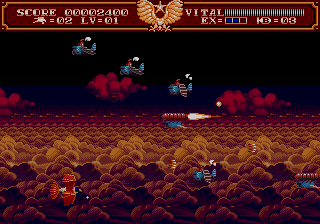 Steel Empire is a bit of an odd title. It almost has a Sky Captain & the World of Tomorrow feel to it with all the steam airships and planes. The only thing about it is that the original designs don’t really add too much to the gameplay, which is pretty standard fair. Everything is well detailed, sure (the game could use a bit more color though), but that’s about as far as it goes. Don’t expect anything innovative and you should be fine. I’m not knocking the game overall, I just feel that had the gameplay been as inspired as the design work, this could have been a much stronger title. The fact that you can blow through it quickly doesn’t help much either. I really did love the whole atmosphere of the game and do take it out for a spin every so often, as it’s worth having if you can find it cheap. Great for an afternoon but you probably won’t need more than that to see everything.
Steel Empire is a bit of an odd title. It almost has a Sky Captain & the World of Tomorrow feel to it with all the steam airships and planes. The only thing about it is that the original designs don’t really add too much to the gameplay, which is pretty standard fair. Everything is well detailed, sure (the game could use a bit more color though), but that’s about as far as it goes. Don’t expect anything innovative and you should be fine. I’m not knocking the game overall, I just feel that had the gameplay been as inspired as the design work, this could have been a much stronger title. The fact that you can blow through it quickly doesn’t help much either. I really did love the whole atmosphere of the game and do take it out for a spin every so often, as it’s worth having if you can find it cheap. Great for an afternoon but you probably won’t need more than that to see everything.
Super Fantasy Zone
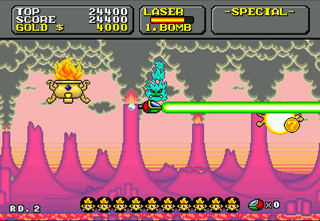 Sega Master System fans know this series well. The adventures of Opa-Opa are legendary on that console (spanning three adventures in total) and although he made the trip to 16-bit, Sega of America was blind enough to not bring it to the U.S. The game was released in Japan and Europe and a PAL copy can be had for cheap on eBay (it’s in English to boot!).
Sega Master System fans know this series well. The adventures of Opa-Opa are legendary on that console (spanning three adventures in total) and although he made the trip to 16-bit, Sega of America was blind enough to not bring it to the U.S. The game was released in Japan and Europe and a PAL copy can be had for cheap on eBay (it’s in English to boot!).
The game plays identically to earlier installments, and this is essentially more of the same. When “the same” constitutes great gameplay and crisp, colorful graphics, there’s no need to change anything. Super Fantasy Zone also sports a neat intro and ending, and this only rounds out an excellent package for those who love blowing things up for coins. All your favorite weapons and items are here and you’ll make good use of them against the huge bosses that are much more dangerous than they look.
The Thunder Force Series
Any fan of the genre knows the Thunder Force games. Loved for its blistering action, awesome bosses, and hardware-pushing graphics, the series is considered by many as the definitive shmup franchise on the Genesis. Thunder Force 2 was originally released alongside the system around launch and while it was a decent game in its own right, it didn’t click with gamers right away. Truxton, the other shmup available (vertical and very good!) attracted more fans with its great gameplay and HUGE bomb detonations. It wasn’t until the third entry in the Force series came out in 1990 that people stood up and took notice. Part three did away with the overhead levels from the previous game and concentrated on making the horizontal levels about as good as coding would allow, even going so far as to let you choose the order of the first four levels (something emulated in many later shmups). Nothing like it had been released and it was the shmup to own that year. It was eventually whored out for a flat, dull port on the SNES called Thunder Spirits.
 Another sequel followed, called Lightening Force (not only did Sega mess with the name, they couldn’t even spell it correctly) and continued the tradition of huge bosses and mind-blowing graphics and was much harder than either of the previous games. It added levels that now scrolled up or down several screens, which made finding that certain power up a major pain.
Another sequel followed, called Lightening Force (not only did Sega mess with the name, they couldn’t even spell it correctly) and continued the tradition of huge bosses and mind-blowing graphics and was much harder than either of the previous games. It added levels that now scrolled up or down several screens, which made finding that certain power up a major pain.
The series would get only one more installment, this time on the Saturn, and then lamentably fade into obscurity. Read more about the franchise in the Thunder Force edition of our Forgotten Franchise article series.
Whip Rush
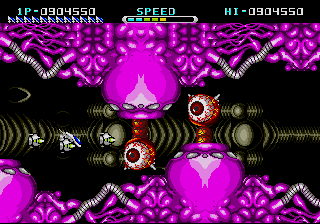 Another one of Renovation’s lineup of shmups for the Genesis, Whip Rush is quite a decent title, especially for an R-Type clone. The graphics are clean, and the sprites are large and well detailed. There’s plenty of parallax and the backgrounds are colorful. The game has all the bells and whistles of a typical shmup from the era and the weapon’s system is nothing to brag about. It’s one of those games that you know is just a blatant copy of another (and much better title) but you decide to play it anyway and just enjoy it for what it is. The gameplay is solid enough, with some good boss battles sprinkled about. Most diehard shmup fans won’t find anything to scream about but those new to the genre will be able to dive right in. Considering that this was one of the first shmups to be released for the Genesis (it retailed for about $70!), I kind of forgive Whip Rush for not having aged as gracefully as other titles have. I would still recommend you pick it up and give it a try though.
Another one of Renovation’s lineup of shmups for the Genesis, Whip Rush is quite a decent title, especially for an R-Type clone. The graphics are clean, and the sprites are large and well detailed. There’s plenty of parallax and the backgrounds are colorful. The game has all the bells and whistles of a typical shmup from the era and the weapon’s system is nothing to brag about. It’s one of those games that you know is just a blatant copy of another (and much better title) but you decide to play it anyway and just enjoy it for what it is. The gameplay is solid enough, with some good boss battles sprinkled about. Most diehard shmup fans won’t find anything to scream about but those new to the genre will be able to dive right in. Considering that this was one of the first shmups to be released for the Genesis (it retailed for about $70!), I kind of forgive Whip Rush for not having aged as gracefully as other titles have. I would still recommend you pick it up and give it a try though.
Wings of Wor
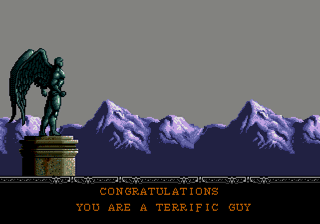 Dreamworks (not the Spielberg one) released a few gems on the Genesis (Target Earth comes to mind) and among them was Wings of Wor. It kind of reminds me of a horizontal Legendary Wings, what with the style of play and all. The main sprite is a bit too small sometimes and there’s often the problem of bullets getting mixed with the backgrounds but more often than not, the game is a blast to play and keeps you on your toes all the way from beginning to end. Massive weapon upgrades give you the necessary firepower to ward off everything but the kitchen sink and you’ll need them. Parallax abounds and there are some neat background effects for such an early title (the earthquake in stage one and stage four’s “lung” background, for example). The music gets the job done and not much else but where this title excels is in the gameplay. Prepare to suffer! Not enough people gave Wings of Wor a chance and they’re doing themselves a disservice by not playing it.
Dreamworks (not the Spielberg one) released a few gems on the Genesis (Target Earth comes to mind) and among them was Wings of Wor. It kind of reminds me of a horizontal Legendary Wings, what with the style of play and all. The main sprite is a bit too small sometimes and there’s often the problem of bullets getting mixed with the backgrounds but more often than not, the game is a blast to play and keeps you on your toes all the way from beginning to end. Massive weapon upgrades give you the necessary firepower to ward off everything but the kitchen sink and you’ll need them. Parallax abounds and there are some neat background effects for such an early title (the earthquake in stage one and stage four’s “lung” background, for example). The music gets the job done and not much else but where this title excels is in the gameplay. Prepare to suffer! Not enough people gave Wings of Wor a chance and they’re doing themselves a disservice by not playing it.
XDR
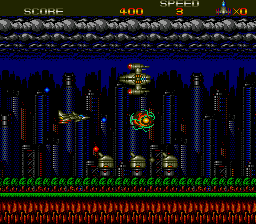 I’ve never heard of Unipacc, the company responsible for XDR. The graphical style reminds of those games done by Sage’s Creation, where all the backgrounds looked like they were first done on the NES, and merely had their color count upped for release on the Genesis. That pretty much sums up XDR, as there’s nothing out of the ordinary or eye catching here. It’s a standard horizontal shmup with a generic weapons system and cliched bosses. The game doesn’t even have an opening sequence (or story at all, for that matter). Sound and music are dull, and even the enemies tend to come at you without any motivation. I bet if you could scream at them to go away, they probably would (wouldn’t that make for an interesting power up?). I know it was released in 1990, but there were many other shmups from that year that tried. XDR doesn’t even try in the slightest to be anything more than a run-of-the-mill outing that puts out just the minimum amount of effort. I was taught to never strive for just the minimum, and that’s why I think I’ll pass on this one.
I’ve never heard of Unipacc, the company responsible for XDR. The graphical style reminds of those games done by Sage’s Creation, where all the backgrounds looked like they were first done on the NES, and merely had their color count upped for release on the Genesis. That pretty much sums up XDR, as there’s nothing out of the ordinary or eye catching here. It’s a standard horizontal shmup with a generic weapons system and cliched bosses. The game doesn’t even have an opening sequence (or story at all, for that matter). Sound and music are dull, and even the enemies tend to come at you without any motivation. I bet if you could scream at them to go away, they probably would (wouldn’t that make for an interesting power up?). I know it was released in 1990, but there were many other shmups from that year that tried. XDR doesn’t even try in the slightest to be anything more than a run-of-the-mill outing that puts out just the minimum amount of effort. I was taught to never strive for just the minimum, and that’s why I think I’ll pass on this one.
Zero Wing
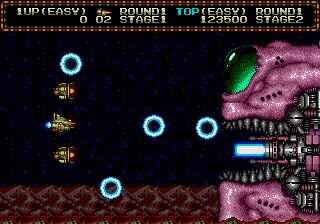 Probably the most famous shmup on the Genesis, it’s ironic that Zero Wing’s fame has little to do with the game itself and comes mostly from the “all your base” comment in the opening cut scene. Once you actually play the game, you find that it’s a tight little shmup that while not on the same level as Thunder Force III or even Wings of Wor, is still pretty good. A decent weapons system goes far towards making up for the middle-of-the-road visuals and the amount of stages is just right. Overall, Zero Wing is another example of a slightly above average shmup that’s worth the $10 or so it should cost you. Just make sure to get the European version, as that cut scene alone is worth the price of admission.
Probably the most famous shmup on the Genesis, it’s ironic that Zero Wing’s fame has little to do with the game itself and comes mostly from the “all your base” comment in the opening cut scene. Once you actually play the game, you find that it’s a tight little shmup that while not on the same level as Thunder Force III or even Wings of Wor, is still pretty good. A decent weapons system goes far towards making up for the middle-of-the-road visuals and the amount of stages is just right. Overall, Zero Wing is another example of a slightly above average shmup that’s worth the $10 or so it should cost you. Just make sure to get the European version, as that cut scene alone is worth the price of admission.
I still wonder to this day why it was never brought over to the states and PAL games that are left in Europe infuriate me. If everything is already translated, bring it over!
Vertical Shmups
For some reason, there has long been a debate as to which are better: horizontal or vertical shmups. Why people even waste their time arguing this is beyond me. A great game is a great game, regardless of the direction it scrolls. For every great horizontal shmup someone identifies, an equally awesome vertical one can be found. Both types have their attractions, and both should be played with the same fervor and energy. I can’t say that I have a preference between the two, and since I’m no shmupping guru, I’m not even going to attempt to wade into that debate.
The Aleste Series
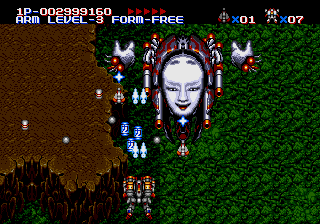 Both the Genesis and the Sega CD were lucky enough to receive two of the six Aleste games. M.U.S.H.A. (Metallic Uniframe Super Hybrid Armor) and Robo Aleste are widely regarded as the two best vertical shmups on the platform. Though Robo Aleste is an awesome game that takes the twitch gameplay from the series to a stunning climax (form what I’m able to gather, it’s the last game in the series), fans clamor to M.U.S.H.A. as the best all around. They aren’t stabbing in the dark either. Upon its release, the game left many jaws nailed to the floor with its incredible graphics and rocking soundtrack. Multiple weapons, each with several levels of power, and a crapload of option assists rounded out an already stellar package. Also, check out our review of Robo Aleste!
Both the Genesis and the Sega CD were lucky enough to receive two of the six Aleste games. M.U.S.H.A. (Metallic Uniframe Super Hybrid Armor) and Robo Aleste are widely regarded as the two best vertical shmups on the platform. Though Robo Aleste is an awesome game that takes the twitch gameplay from the series to a stunning climax (form what I’m able to gather, it’s the last game in the series), fans clamor to M.U.S.H.A. as the best all around. They aren’t stabbing in the dark either. Upon its release, the game left many jaws nailed to the floor with its incredible graphics and rocking soundtrack. Multiple weapons, each with several levels of power, and a crapload of option assists rounded out an already stellar package. Also, check out our review of Robo Aleste!
I really like Robo Aleste but I’m the first to admit that it doesn’t hold up to its Genesis sibling. The storyline is kind of hard to swallow (M.U.S.H.A.‘s story is great) and the gameplay just doesn’t seem to flow the same way. Should you buy it? By all means. It’s a wonderful game that ends the series with a bang. The music alone is worth the price of admission.
Battle Squadron
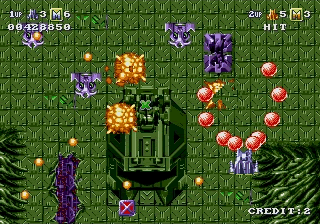 Electronic Arts releasing a shmup? How’s that for weird? Done in the same mold as the classic Toaplan shmup, like Twin Cobra (arcade), and Fire Shark, Battle Squadron lacks all of the charm of those titles and is simply too generic for its own good. The genre was in a bit of a rut on the Genesis in 1990, with most titles looking very much like each other, and that’s what we have here. There are a few cool things though, like the two-player simultaneous option, and the ability to determine how many enemy shots will be onscreen at once and their speed (in the options menu). The cloaked enemy ships are a neat feature as well. The only real problem I had with Battle Squadron was in its gameplay. Being allowed to retain a power up after death is useless when the initial invincibility your new ship receives is barely enough to make it onscreen. Seriously, you’ll find yourself losing a life practically before you even realize that it was there. The painfully slow movement of your vessel doesn’t help matters much, and enemies take far too long to kill sometimes (what’s with the power up capsule? It’s fricken’ invincible!). If you can get through these problems, you might actually enjoy Battle Squadron. Just don’t pay over $5 for it.
Electronic Arts releasing a shmup? How’s that for weird? Done in the same mold as the classic Toaplan shmup, like Twin Cobra (arcade), and Fire Shark, Battle Squadron lacks all of the charm of those titles and is simply too generic for its own good. The genre was in a bit of a rut on the Genesis in 1990, with most titles looking very much like each other, and that’s what we have here. There are a few cool things though, like the two-player simultaneous option, and the ability to determine how many enemy shots will be onscreen at once and their speed (in the options menu). The cloaked enemy ships are a neat feature as well. The only real problem I had with Battle Squadron was in its gameplay. Being allowed to retain a power up after death is useless when the initial invincibility your new ship receives is barely enough to make it onscreen. Seriously, you’ll find yourself losing a life practically before you even realize that it was there. The painfully slow movement of your vessel doesn’t help matters much, and enemies take far too long to kill sometimes (what’s with the power up capsule? It’s fricken’ invincible!). If you can get through these problems, you might actually enjoy Battle Squadron. Just don’t pay over $5 for it.
Crossfire
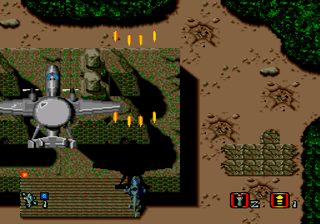 I must admit that I wasn’t expecting all that much when I first booted up Crossfire. Imagine my surprise when I found out what a great game it is! Based on the 80 series Airwolf (the game is called Super Airwolf outside of Japan), it plays very Toaplan-esque, but actually adds some new dynamics to that established formula. For example, your helicopter has a a turbo option that creates an impenetrable shield around it for a small time, letting you get through some tough situations. Moreover, you can choose your craft’s armament between stages. The standard bomb set for wiping out foes is present as well, but the most interesting feature here is the addition of run-‘n-gun levels. After you pass a stage, you have to infiltrate the area and complete an objective. This is done by plowing through enemy infantry in your copter until you reach the drop zone. Once there, you take command of your second crewman in Ikari Warrior-style levels. The graphics and sound are decent, and the gameplay is great, and I was very pleased with its innovation, given that it was released pretty early in the Genesis’ cycle. Crossfire is a sleeper that deserves to be checked out.
I must admit that I wasn’t expecting all that much when I first booted up Crossfire. Imagine my surprise when I found out what a great game it is! Based on the 80 series Airwolf (the game is called Super Airwolf outside of Japan), it plays very Toaplan-esque, but actually adds some new dynamics to that established formula. For example, your helicopter has a a turbo option that creates an impenetrable shield around it for a small time, letting you get through some tough situations. Moreover, you can choose your craft’s armament between stages. The standard bomb set for wiping out foes is present as well, but the most interesting feature here is the addition of run-‘n-gun levels. After you pass a stage, you have to infiltrate the area and complete an objective. This is done by plowing through enemy infantry in your copter until you reach the drop zone. Once there, you take command of your second crewman in Ikari Warrior-style levels. The graphics and sound are decent, and the gameplay is great, and I was very pleased with its innovation, given that it was released pretty early in the Genesis’ cycle. Crossfire is a sleeper that deserves to be checked out.
Dangerous Seed
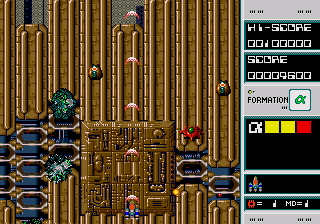 Namco’s first entry in the genre (it would soon be followed by Burning Force), Dangerous Seed is a top-down shmup that doesn’t look like much at first, but slowly grows on you as you play. The graphics are very arcadey-looking, and there isn’t much detail, but the game is never really ugly. True, it pales in comparison to the arcade original, but what can you do? The sound and music are also forgettable, which seems to be typical of this type of early Genesis shmup, but the gameplay is solid. My only gripe is that it can be too easy at times. Enemies tend to not fire at you when they are near the bottom of the screen, and your ship’s life bar erases any possible run for skill. This makes it far too easy to get through a level, as you practically don’t have to fire at or worry about almost half the screen. Compounding the problem is that you have between three and five lives at start, so a single credit can last a long time. The power up system is nothing too interesting either and seems quite primitive next to those of other games released at the same time. I wouldn’t recommend Dangerous Seed for a diehard shmup fan looking for a bullet-hell fix, but it’s worth spending some time with.
Namco’s first entry in the genre (it would soon be followed by Burning Force), Dangerous Seed is a top-down shmup that doesn’t look like much at first, but slowly grows on you as you play. The graphics are very arcadey-looking, and there isn’t much detail, but the game is never really ugly. True, it pales in comparison to the arcade original, but what can you do? The sound and music are also forgettable, which seems to be typical of this type of early Genesis shmup, but the gameplay is solid. My only gripe is that it can be too easy at times. Enemies tend to not fire at you when they are near the bottom of the screen, and your ship’s life bar erases any possible run for skill. This makes it far too easy to get through a level, as you practically don’t have to fire at or worry about almost half the screen. Compounding the problem is that you have between three and five lives at start, so a single credit can last a long time. The power up system is nothing too interesting either and seems quite primitive next to those of other games released at the same time. I wouldn’t recommend Dangerous Seed for a diehard shmup fan looking for a bullet-hell fix, but it’s worth spending some time with.
Darwin 4081
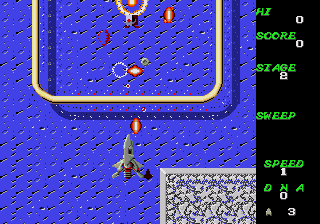 Another Data East game reprogrammed by Sega, Darwin 4081 tries to be innovative with its weapons system. As the name implies, your ship undergoes several evolutionary changes as you acquire power ups, making for some interesting combinations. Unfortunately, that’s about the only innovative thing about this game, as everything else is very bland and uninspired. For a game that came out on the Genesis in 1990, it doesn’t make the slightest attempt to use any of the system’s new capabilities and looks quite dated. The gameplay is adequate, but most people won’t get play long enough to realize this, since Darwin is just so ho-hum to look at. There is an upside, though. you can score a complete copy for next to nothing on eBay, and once you get past the aesthetics (it’s no aural picnic either), you’ll find that there’s a pretty entertaining little shmup under the dull sheen. Your ships’ evolution is pretty cool and this is a concept that should be brought back. Besides, what other shmup lets you use a flying squid?
Another Data East game reprogrammed by Sega, Darwin 4081 tries to be innovative with its weapons system. As the name implies, your ship undergoes several evolutionary changes as you acquire power ups, making for some interesting combinations. Unfortunately, that’s about the only innovative thing about this game, as everything else is very bland and uninspired. For a game that came out on the Genesis in 1990, it doesn’t make the slightest attempt to use any of the system’s new capabilities and looks quite dated. The gameplay is adequate, but most people won’t get play long enough to realize this, since Darwin is just so ho-hum to look at. There is an upside, though. you can score a complete copy for next to nothing on eBay, and once you get past the aesthetics (it’s no aural picnic either), you’ll find that there’s a pretty entertaining little shmup under the dull sheen. Your ships’ evolution is pretty cool and this is a concept that should be brought back. Besides, what other shmup lets you use a flying squid?
Divine Sealing
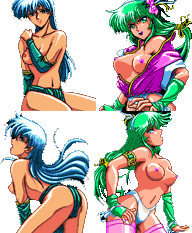 What the hell is this? A game centered around soft-core porn? Before you get any ideas, be warned that the work (yes, work) you’ll have to go through to actually see anything is more tedious than surfing the net for porn, and probably more rewarding. If you can bring yourself to play through an entire level of this horrid game, you’ll be given a static image of some anime lovely for your enjoyment. There’s a buttload of text to go with it all, and I would really like to know what the reason for all the nudity is. It appears that Earth’s last hope was some sort of a pimp, and our hero isn’t content with being the savior of mankind. He must make a booty call between stages! Seriously, all that’s missing is a pair of tentacles for the image to be complete. Bland, repetitive gameplay, virtually no power ups, and some of the worse music ever stuffed into a cart are enough to send this one packing. Even the bosses appeared bored, and their attack patterns are absurdly simple and predictable. Honestly, I cannot find a single redeeming feature about Divine Sealing, which is why some people will probably now seek out a copy. It at least makes for interesting conversation.
What the hell is this? A game centered around soft-core porn? Before you get any ideas, be warned that the work (yes, work) you’ll have to go through to actually see anything is more tedious than surfing the net for porn, and probably more rewarding. If you can bring yourself to play through an entire level of this horrid game, you’ll be given a static image of some anime lovely for your enjoyment. There’s a buttload of text to go with it all, and I would really like to know what the reason for all the nudity is. It appears that Earth’s last hope was some sort of a pimp, and our hero isn’t content with being the savior of mankind. He must make a booty call between stages! Seriously, all that’s missing is a pair of tentacles for the image to be complete. Bland, repetitive gameplay, virtually no power ups, and some of the worse music ever stuffed into a cart are enough to send this one packing. Even the bosses appeared bored, and their attack patterns are absurdly simple and predictable. Honestly, I cannot find a single redeeming feature about Divine Sealing, which is why some people will probably now seek out a copy. It at least makes for interesting conversation.
Earth Defend/Earth Defense
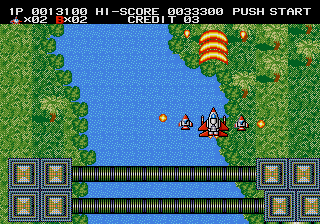 The ugly Engrish title you see above here is actually one of the pronunciations of the game’s real name, Earth Defense, Realtec’s unlicensed shmup that deservedly never got a seal of approval from Sega. To say that this game is bad is more than an understatement; it’s an injustice. The thing that impacted me the most is that Earth Defense was released in 1995, well into the twilight of the Genesis’ dominance. Where are all the graphical effects? Rockin’ soundtrack? Where’s the actual game? Worse than homebrew shareware, you need to stay as far away from this steaming pile as humanly possible. Horrible graphics, terrible sound, and EZ Doze gameplay are all the hallmarks of a bad shmup. Needless to say, Earth Defense qualifies in all areas. For all the shmups available on the Genesis, most are surprisingly good. The few that don’t measure up all bow in fear before this game. I’ve heard people buy Earth Defense just for the cheese factor; it seems that boasting about owning a turd is something of a trend nowadays. If that’s your thing, get this and a copy of Divine Sealing and be the envy of all your friends.
The ugly Engrish title you see above here is actually one of the pronunciations of the game’s real name, Earth Defense, Realtec’s unlicensed shmup that deservedly never got a seal of approval from Sega. To say that this game is bad is more than an understatement; it’s an injustice. The thing that impacted me the most is that Earth Defense was released in 1995, well into the twilight of the Genesis’ dominance. Where are all the graphical effects? Rockin’ soundtrack? Where’s the actual game? Worse than homebrew shareware, you need to stay as far away from this steaming pile as humanly possible. Horrible graphics, terrible sound, and EZ Doze gameplay are all the hallmarks of a bad shmup. Needless to say, Earth Defense qualifies in all areas. For all the shmups available on the Genesis, most are surprisingly good. The few that don’t measure up all bow in fear before this game. I’ve heard people buy Earth Defense just for the cheese factor; it seems that boasting about owning a turd is something of a trend nowadays. If that’s your thing, get this and a copy of Divine Sealing and be the envy of all your friends.
Elemental Master
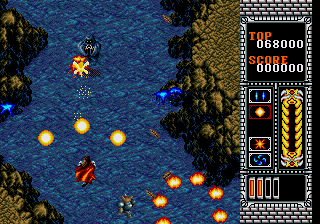 Typically, people associate Techno Soft with the Thunder Force series. They did, however, make a fine vertical shmup that was released in 1990 called Elemental Master. Though not as innovative or revolutionary as Thunder Force, it was still a solid title that’s great fun to play. Strangely enough, Renovation published it, even though Sega had handled most of Techno Soft’s previous outings (Herzog Zwei, Thunder Force 2).
Typically, people associate Techno Soft with the Thunder Force series. They did, however, make a fine vertical shmup that was released in 1990 called Elemental Master. Though not as innovative or revolutionary as Thunder Force, it was still a solid title that’s great fun to play. Strangely enough, Renovation published it, even though Sega had handled most of Techno Soft’s previous outings (Herzog Zwei, Thunder Force 2).
Visually, Elemental Master is nothing to write home about. The graphics are very middle-of-the-road and don’t really take advantage of the hardware. The gameplay is more or less on the same level, with your hero casting spells instead of lugging around a huge cannon of some sort. The bosses are a high point, as some of them are very well drawn and offer a decent challenge. Far too often, though, this game is compared to Techno Soft’s other famous franchise. That is both unfair and unnecessary. Elemental Master is a totally different type of game and honestly, were we to compare most shmups to Thunder Force III or Lightening Force, many would come up short. I take this game for what it is: a decent little shmup that doesn’t bring the house down but is still a fun and worthwhile purchase.
Fire Shark
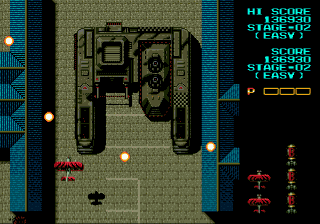 This is definitely one of my favorites! Yet another of Dreamworks great releases, Fire Shark was a great port that still holds up very well today. It was one of the first vertical shmups released for the Genesis, which is remarkable, considering how well it still plays and looks. I guess that had a lot to do with the arcade source material, and the Genesis port is very faithful to that version. I always wondered how come Fire Shark came out so well but Twin Cobra, which was released much later, was so mediocre. I guess it has to do with the fact that American Treco ported Twin Cobra, whereas Toaplan did Fire Shark themselves. The lack of a two-player mode brings it down a notch but the solid gameplay and decent graphics more than make up for that oversight. Weapons can be powered up to an insane level and you also have an incredibly powerful bomb that can be deployed in succession, for devastating damage. Although it’s a bit easy, Fire Shark is a great shmup that comes highly recommended.
This is definitely one of my favorites! Yet another of Dreamworks great releases, Fire Shark was a great port that still holds up very well today. It was one of the first vertical shmups released for the Genesis, which is remarkable, considering how well it still plays and looks. I guess that had a lot to do with the arcade source material, and the Genesis port is very faithful to that version. I always wondered how come Fire Shark came out so well but Twin Cobra, which was released much later, was so mediocre. I guess it has to do with the fact that American Treco ported Twin Cobra, whereas Toaplan did Fire Shark themselves. The lack of a two-player mode brings it down a notch but the solid gameplay and decent graphics more than make up for that oversight. Weapons can be powered up to an insane level and you also have an incredibly powerful bomb that can be deployed in succession, for devastating damage. Although it’s a bit easy, Fire Shark is a great shmup that comes highly recommended.
Grind Stormer
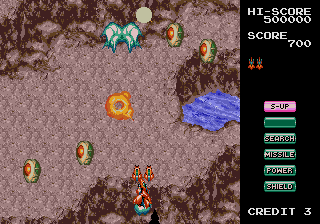 Ah, another Toaplan shmup. They’re my favorites, by far, and Grind Stormer does a good job of emulating its arcade relative. The graphics aren’t as clean or detailed here, and the sound has taken a hit, but the gameplay is intact. The weapon upgrade system is pretty standard, requiring you to power up each shot several times to increase effectiveness. They’re powerful too, and a fully powered blast can be a lovely thing to watch. If there’s anything particularly negative about Grind Stormer, it’s that the levels can sometimes be too long, and playing through the whole game can take a pretty fair chunk of time, something not typical for a shmup. That might actually be a good thing, as blowing through a game in 20 minutes, especially one meant to test your reflexes, tends to leave one with a desire for more.
Ah, another Toaplan shmup. They’re my favorites, by far, and Grind Stormer does a good job of emulating its arcade relative. The graphics aren’t as clean or detailed here, and the sound has taken a hit, but the gameplay is intact. The weapon upgrade system is pretty standard, requiring you to power up each shot several times to increase effectiveness. They’re powerful too, and a fully powered blast can be a lovely thing to watch. If there’s anything particularly negative about Grind Stormer, it’s that the levels can sometimes be too long, and playing through the whole game can take a pretty fair chunk of time, something not typical for a shmup. That might actually be a good thing, as blowing through a game in 20 minutes, especially one meant to test your reflexes, tends to leave one with a desire for more.
Tengen released Grind Stormer in the U.S. and I’ve heard of several people with faulty carts (happened to me too). Be sure to test before you buy.
Magic Girl
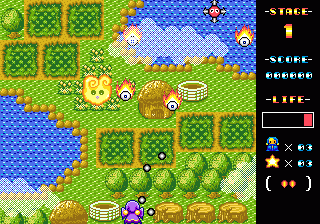 Don’t let Magic Girl‘s cute-’em-up facade fool you. This baby’s hard! Enemies swarm you from all sides (they mostly come from behind), and bullets are everywhere. Your little witch could give Cotton a run for her money though, with a pretty wide range of power ups, including many, many shields. Even though it comes at you with bright, colorful graphics and most of the enemies are cute little jelly monsters and stars, this is twitch gameplay through and through. Your meager little life bar drops faster than a stripper’s top on a Friday night, and the three bombs you start out with don’t do much at all. The bosses are fun and huge, and anyone who plays this will instantly know why Magic Girl wasn’t brought to the U.S., although Keio Flying Squadron is more or less in the same vein and was released here. If you can find a copy, which will be a chore, you need to pick this one up. I was very impressed with how well it played and looked and can recommend it wholeheartedly. Not all shmups need to pit one man against a fleet of mechanized alien invaders to be good, and Magic Girl is a great example of this.
Don’t let Magic Girl‘s cute-’em-up facade fool you. This baby’s hard! Enemies swarm you from all sides (they mostly come from behind), and bullets are everywhere. Your little witch could give Cotton a run for her money though, with a pretty wide range of power ups, including many, many shields. Even though it comes at you with bright, colorful graphics and most of the enemies are cute little jelly monsters and stars, this is twitch gameplay through and through. Your meager little life bar drops faster than a stripper’s top on a Friday night, and the three bombs you start out with don’t do much at all. The bosses are fun and huge, and anyone who plays this will instantly know why Magic Girl wasn’t brought to the U.S., although Keio Flying Squadron is more or less in the same vein and was released here. If you can find a copy, which will be a chore, you need to pick this one up. I was very impressed with how well it played and looked and can recommend it wholeheartedly. Not all shmups need to pit one man against a fleet of mechanized alien invaders to be good, and Magic Girl is a great example of this.
Master of Weapon
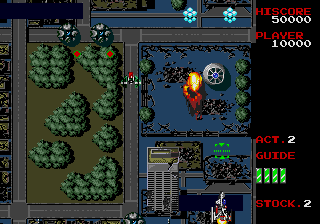 Oh my god. I cannot believe that I played this game for so long. What at first looks like a fun, back-to-basics shmup turns out to be the most underwhelming experience I’ve had doing this article. While I was initially enthusiastic about the combination of shooting and bombing (I love that), any good feelings I had towards this game disappeared as soon as I hit something. The sound of your fire has to be the single most grating and annoying effect in gaming. Seriously, play this game with your stereo too loud and you will blow your speakers; it’s that bad. The music is equally horrible, and only after I desperately hit the mute button was I able to actually play. Unfortunately, what was left was no better. It’s ironic that a shmup called Master of Weapon has one of the worst power ups in the genre. After taking on several capsules, your shot is no more powerful than it was when you started, and all are equally useless against the laughable bosses against which you have to fight. The worst culprit of all? The abnormally large hit box that gets you killed for even flying alongside a bullet. Blech. Avoid.
Oh my god. I cannot believe that I played this game for so long. What at first looks like a fun, back-to-basics shmup turns out to be the most underwhelming experience I’ve had doing this article. While I was initially enthusiastic about the combination of shooting and bombing (I love that), any good feelings I had towards this game disappeared as soon as I hit something. The sound of your fire has to be the single most grating and annoying effect in gaming. Seriously, play this game with your stereo too loud and you will blow your speakers; it’s that bad. The music is equally horrible, and only after I desperately hit the mute button was I able to actually play. Unfortunately, what was left was no better. It’s ironic that a shmup called Master of Weapon has one of the worst power ups in the genre. After taking on several capsules, your shot is no more powerful than it was when you started, and all are equally useless against the laughable bosses against which you have to fight. The worst culprit of all? The abnormally large hit box that gets you killed for even flying alongside a bullet. Blech. Avoid.
Mega SWIV
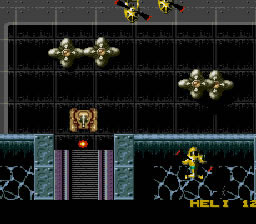 Known as Firepower 2000 on the SNES, Mega SWIV tells the tale of an underground army stealing military equipment from around the world to use against mankind. Yes, the story is cheesy, and the gameplay isn’t much better. Two people can play at the same time, but the game doesn’t get much better. The levels and enemies have supposedly been improved over the SNES version, and I’d hate to see what they were like if this is meant to be an improvement. It’s not that Mega SWIV is necessarily bad; it’s just so underwhelming that it lost my interest quite quickly. The firing system (especially for the jeep) is annoying, since you have to press once to fire, and once more to hold the direction. This can be a big pain when you’re attacked from all sides, even more so since touching the walls means instant death! Power ups are too sporadic and ineffective, and the music just gets on your nerves. Fortunately, you won’t have to live with the realization that you overspent on Mega SWIV, as it’s not all that expensive. I recommend buying Verytex or Fire Shark for your top-down shmup fix instead.
Known as Firepower 2000 on the SNES, Mega SWIV tells the tale of an underground army stealing military equipment from around the world to use against mankind. Yes, the story is cheesy, and the gameplay isn’t much better. Two people can play at the same time, but the game doesn’t get much better. The levels and enemies have supposedly been improved over the SNES version, and I’d hate to see what they were like if this is meant to be an improvement. It’s not that Mega SWIV is necessarily bad; it’s just so underwhelming that it lost my interest quite quickly. The firing system (especially for the jeep) is annoying, since you have to press once to fire, and once more to hold the direction. This can be a big pain when you’re attacked from all sides, even more so since touching the walls means instant death! Power ups are too sporadic and ineffective, and the music just gets on your nerves. Fortunately, you won’t have to live with the realization that you overspent on Mega SWIV, as it’s not all that expensive. I recommend buying Verytex or Fire Shark for your top-down shmup fix instead.
Phelios
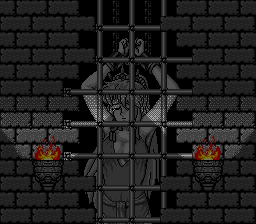 From Starbase299: For those old enough to remember, Namco did do some shooters long before they entered the fighting genre. Among them was this vertical scroller for the growing Genesis system. While it received some very high marks in the magazines back in the day as being a pretty good and intense shooter, it pales to that extent when looked at today, especially when compared to a few other shooters from the same time period. It’s not a bad game at all, just probably not worthy of a 9 like others had awarded it. While it has plenty of levels and some enemies to shoot at, it had some decent graphics and okay sounds to go along with it. The title is probably best only for a shooter freak’s collection or a game collector nowadays, as it’s becoming a harder game to find simply due to age. Namco collectors are probably out gobbling up the remaining copies too.
From Starbase299: For those old enough to remember, Namco did do some shooters long before they entered the fighting genre. Among them was this vertical scroller for the growing Genesis system. While it received some very high marks in the magazines back in the day as being a pretty good and intense shooter, it pales to that extent when looked at today, especially when compared to a few other shooters from the same time period. It’s not a bad game at all, just probably not worthy of a 9 like others had awarded it. While it has plenty of levels and some enemies to shoot at, it had some decent graphics and okay sounds to go along with it. The title is probably best only for a shooter freak’s collection or a game collector nowadays, as it’s becoming a harder game to find simply due to age. Namco collectors are probably out gobbling up the remaining copies too.
Ghostwalker pretty much summed up my feelings on Phelios. Have a different opinion? Why not read our review and see how it compares?
Raiden Trad
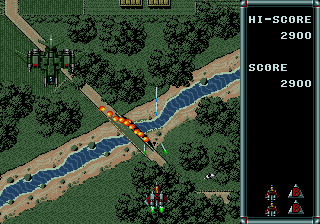 Sporting a $70 price tag at release, Raiden Trad was one of those games that kept people away. Given the fact that you could get Thunder Force III at the time for $20 less, I can see why. Of course, there were always a few people willing to risk it (read about one of them in vol. 2 of Stories from the Book of Genesis), but I doubt they got their money’s worth. Raiden Trad isn’t a bad game at all; I’m just not sure if it was worth that much cash. What you got was a solid entry in the series with a decent weapons system. There’s just nothing here to “wow” you. Although it’s not as colorful as its SNES sibling, I actually think it plays better. The Raiden series introduced me to top-down shmups, and it’s nice to see that it’s lasted as long as it has.
Sporting a $70 price tag at release, Raiden Trad was one of those games that kept people away. Given the fact that you could get Thunder Force III at the time for $20 less, I can see why. Of course, there were always a few people willing to risk it (read about one of them in vol. 2 of Stories from the Book of Genesis), but I doubt they got their money’s worth. Raiden Trad isn’t a bad game at all; I’m just not sure if it was worth that much cash. What you got was a solid entry in the series with a decent weapons system. There’s just nothing here to “wow” you. Although it’s not as colorful as its SNES sibling, I actually think it plays better. The Raiden series introduced me to top-down shmups, and it’s nice to see that it’s lasted as long as it has.
Note: I’ve seen two different versions of the box art (I got the ugly, green Micronet one), and I assume the other, red Bignet cover is rarer.
Silpheed
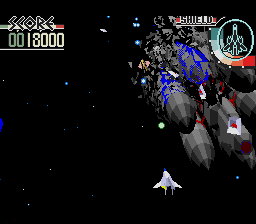 When it first appeared on the Sega CD back in 1993, Silpheed wowed gamers with some of the most incredible graphics available on any console at the time. Years later, the novelty has worn off and the flat-shaded polygons no longer impress like they used to; however, the game is as solid as ever. A traditional top-down shmup with a brutal difficulty level, Silpheed is still a great reason to own a Sega CD. Game Arts did a great job showing what the system was capable of, and the game screams quality on all levels. Simple in execution, it can sometimes be its own enemy, as gamers will tend to get distracted by the huge explosions or rotating backgrounds and end up losing a life. Even so, there’s no reason for you not to have this game in your collection.
When it first appeared on the Sega CD back in 1993, Silpheed wowed gamers with some of the most incredible graphics available on any console at the time. Years later, the novelty has worn off and the flat-shaded polygons no longer impress like they used to; however, the game is as solid as ever. A traditional top-down shmup with a brutal difficulty level, Silpheed is still a great reason to own a Sega CD. Game Arts did a great job showing what the system was capable of, and the game screams quality on all levels. Simple in execution, it can sometimes be its own enemy, as gamers will tend to get distracted by the huge explosions or rotating backgrounds and end up losing a life. Even so, there’s no reason for you not to have this game in your collection.
I’ve often wondered why people tend to ride Silpheed‘s gameplay but praise Axelay on the SNES. Both games are quite similar in that they make terrific use of their respective console’s special effects.
Slap Fight
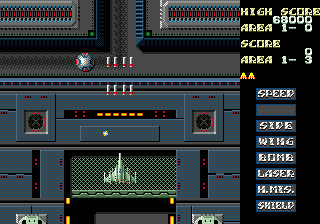 Wow, this is an interesting find. It’s not every day you see a game ported to a system that launched three years after it was released. Slap Fight, released in arcades in 1986, was a Toaplan game (seems to be a lot of them here) from the early days of vertical shmups. It finally made its way to the Genesis in 1993, via Tengen, and would have been terribly outdated, brought over intact. Thankfully, the developers saw fit to include an exclusive Mega Drive version, which is an entirely new game!
Wow, this is an interesting find. It’s not every day you see a game ported to a system that launched three years after it was released. Slap Fight, released in arcades in 1986, was a Toaplan game (seems to be a lot of them here) from the early days of vertical shmups. It finally made its way to the Genesis in 1993, via Tengen, and would have been terribly outdated, brought over intact. Thankfully, the developers saw fit to include an exclusive Mega Drive version, which is an entirely new game!
Similar to Astro Warrior in presentation, you collect stars instead of capsules to power up your weapons. As you collect them, your ship transforms until you attain the mighty Power Wing, which almost tripled your size and made for some great firepower. It takes a bit too long to get up to an acceptable speed, but other than that this game is great. The extra mode adds immeasurably to its shelf life and the action is enough to keep you coming back for more.
Space Turtle Battleship
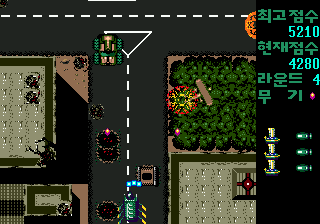 Now here’s a rarity for you. Distributed in Korea by Samsung, Space Turtle Battleship, or Keo-Buk-Son översatt, was released in 1992 and was promptly passed over by every U.S. publisher known to man. It’s a strange game, to be sure, and comes off as something of an amalgam of shmups from the era. One stage you’re in space, fighting off enemy craft Truxton-like, and the minute you’re tearing through an area that looks like it leapt from Twin Cobra. I can’t read Korean, but I’d really love to know how tanks and helicopters fit into all of this! There’s no relation to the classic anime Space Battleship Yamato, so forget that route, but there does seem to be some history involved here. Supposedly, the Korean Turtle Ships were ironclad crafts built in Korea in 1592 and helped the country defeat Japan. The man responsible, Admiral Yi, became one of the most famous military leaders in their history. Quite an interesting story, as historical backgrounds aren’t typical in the genre.
Now here’s a rarity for you. Distributed in Korea by Samsung, Space Turtle Battleship, or Keo-Buk-Son översatt, was released in 1992 and was promptly passed over by every U.S. publisher known to man. It’s a strange game, to be sure, and comes off as something of an amalgam of shmups from the era. One stage you’re in space, fighting off enemy craft Truxton-like, and the minute you’re tearing through an area that looks like it leapt from Twin Cobra. I can’t read Korean, but I’d really love to know how tanks and helicopters fit into all of this! There’s no relation to the classic anime Space Battleship Yamato, so forget that route, but there does seem to be some history involved here. Supposedly, the Korean Turtle Ships were ironclad crafts built in Korea in 1592 and helped the country defeat Japan. The man responsible, Admiral Yi, became one of the most famous military leaders in their history. Quite an interesting story, as historical backgrounds aren’t typical in the genre.
How this all relates to a vertical scrolling shmup is beyond me, but you can see the main vehicle is a turtle ship. The graphics and gameplay are decent enough, but I’m sure it will appeal to collectors more for its quirkiness and rarity than anything else.
Task Force Harrier EX
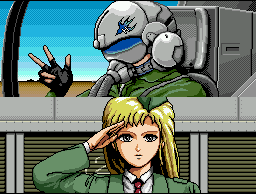 Treco’s second shmup on the Genesis fares much better than the first, with tighter gameplay and a great weapons system (good opening cut scene too!). Task Force Harrier EX puts you in the pilot seat of a modern jet armed with more weaponry than should be possible to fly with. Though the enemy sprites are small, they’re clear and well-detailed, and each stage is brimming with things to destroy. Of the whole package, I’m particularly impressed with the weapons options you receive. Having the ability to move them around M.U.S.H.A-style gives you greater freedom and ability to take out foes coming in from the sides and behind. The standard weapon is also quite powerful from the get-go, with a decent range of fire and auto bombing to eliminate foes on the ground. Your bomb set is kind of weak, but the overall strength of your firepower counteracts well enough. All in all, Task Force Harrier EX is pretty faithful to the arcade original and doesn’t tend to come up often whenever people discuss Genesis shmups. That’s a shame, as it’s a pretty darn good game.
Treco’s second shmup on the Genesis fares much better than the first, with tighter gameplay and a great weapons system (good opening cut scene too!). Task Force Harrier EX puts you in the pilot seat of a modern jet armed with more weaponry than should be possible to fly with. Though the enemy sprites are small, they’re clear and well-detailed, and each stage is brimming with things to destroy. Of the whole package, I’m particularly impressed with the weapons options you receive. Having the ability to move them around M.U.S.H.A-style gives you greater freedom and ability to take out foes coming in from the sides and behind. The standard weapon is also quite powerful from the get-go, with a decent range of fire and auto bombing to eliminate foes on the ground. Your bomb set is kind of weak, but the overall strength of your firepower counteracts well enough. All in all, Task Force Harrier EX is pretty faithful to the arcade original and doesn’t tend to come up often whenever people discuss Genesis shmups. That’s a shame, as it’s a pretty darn good game.
Thunderbolt II
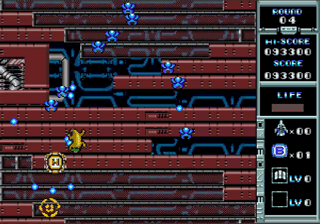 Another unlicensed title, this one hails from China and was released by Gametec. A slightly different version was also released for the Famicom, and both are quite rare. Like Space Turtle Battleship, Thunderbolt II is a game most people might mistake for a bootleg at first glance, but it is indeed a legit title. It has a decent weapons system, and it’s somewhat challenging, which makes it a good game for shooter fans looking for something new to play. A word of caution though: Thunderbolt II can be quite difficult to find, especially in complete condition, and such copies tend to fetch high prices. If you can find one though, it’s actually a fun little shmup that sports some decent presentation and gameplay. It’ll also make for one heck of a conversation piece in your collection. Just put it on the shelf next to Divine Sealing and watch the heads asplode!
Another unlicensed title, this one hails from China and was released by Gametec. A slightly different version was also released for the Famicom, and both are quite rare. Like Space Turtle Battleship, Thunderbolt II is a game most people might mistake for a bootleg at first glance, but it is indeed a legit title. It has a decent weapons system, and it’s somewhat challenging, which makes it a good game for shooter fans looking for something new to play. A word of caution though: Thunderbolt II can be quite difficult to find, especially in complete condition, and such copies tend to fetch high prices. If you can find one though, it’s actually a fun little shmup that sports some decent presentation and gameplay. It’ll also make for one heck of a conversation piece in your collection. Just put it on the shelf next to Divine Sealing and watch the heads asplode!
Truxton
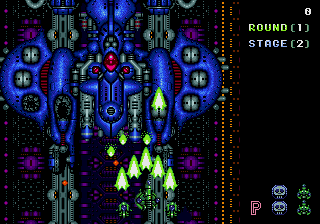 One of my favorite shmups of all time, Truxton was a Genesis launch title that some people blew off without ever giving a chance, due to its insane length. They don’t know what they’re missing. Press that start button and vertical scrolling madness ensues as you plow your way through five levels that are longer than the line at the DMV and harder than a pit bull’s bite. Weapon power ups are insane (three-way lasers!) and the bomb detonation still gives some people nightmares. The story is typical of most shmups: non-existent. That’s not a problem, as once you unleash the staggering fury of your SUPER FIGHTER’s weaponry upon your foes, powering up your weapon will be the only thing on your mind. A friend of mine said that you could only finish the game completely by beating it five times. In my innocence, I gleefully accepted the challenge only to find out that it wasn’t true. Still, I had a great time playing and the experience cemented my love of Truxton for all time.
One of my favorite shmups of all time, Truxton was a Genesis launch title that some people blew off without ever giving a chance, due to its insane length. They don’t know what they’re missing. Press that start button and vertical scrolling madness ensues as you plow your way through five levels that are longer than the line at the DMV and harder than a pit bull’s bite. Weapon power ups are insane (three-way lasers!) and the bomb detonation still gives some people nightmares. The story is typical of most shmups: non-existent. That’s not a problem, as once you unleash the staggering fury of your SUPER FIGHTER’s weaponry upon your foes, powering up your weapon will be the only thing on your mind. A friend of mine said that you could only finish the game completely by beating it five times. In my innocence, I gleefully accepted the challenge only to find out that it wasn’t true. Still, I had a great time playing and the experience cemented my love of Truxton for all time.
Twin Cobra
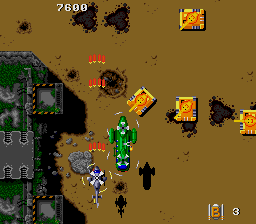 Ugh. I can’t say how disappointed I am at the way Twin Cobra turned out on the Genesis. Only marginally better than Tiger Heli on the NES, the game looks no better here. That says a lot, considering how amazing the arcade game was. I’m a big Toaplan fan, and this was something I was really looking forward to. Imagine my surprise at the underwhelming display I encountered upon first booting this up. The gameplay is mostly there, but the game looks so bad that it just took all the wind out of my sails. Everything is poorly detailed and animated, and the Toaplan charm that usually permeates throughout their games is blatantly absent. I don’t understand what happened here, as Fire Shark is simply amazing on the Genesis, and even Twin Hawk was decent. I guess things just didn’t pan out here, and the result is a mediocre game that looks much worse than a 16-bit port should.
Ugh. I can’t say how disappointed I am at the way Twin Cobra turned out on the Genesis. Only marginally better than Tiger Heli on the NES, the game looks no better here. That says a lot, considering how amazing the arcade game was. I’m a big Toaplan fan, and this was something I was really looking forward to. Imagine my surprise at the underwhelming display I encountered upon first booting this up. The gameplay is mostly there, but the game looks so bad that it just took all the wind out of my sails. Everything is poorly detailed and animated, and the Toaplan charm that usually permeates throughout their games is blatantly absent. I don’t understand what happened here, as Fire Shark is simply amazing on the Genesis, and even Twin Hawk was decent. I guess things just didn’t pan out here, and the result is a mediocre game that looks much worse than a 16-bit port should.
Twin Hawk
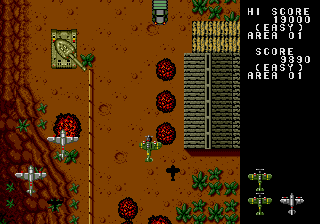 You might know this one as Dai Sen Pu Hurricane, and if you don’t shame on you! Twin Hawk is lots of fun to play, although the lack of a two-player mode is a downer. Toaplan seems to have liked the Genesis a lot, and we got a bunch of their shmups (some better than others, right Twin Cobra?). World War II makes for all sorts of great games, and this is among the better games in the genre to use the theme. It foregoes the standard bomb set and instead gives you a small squadron of planes to call. They don’t last very long but do nicely at taking enemy fire, which makes things easier for you. This little import goodie has better than average graphics and decent sound, and plays very smoothly. The only problem I had was that they replaced the bomb, instead of adding the squadron along with it. Boss battles can be a bit more difficult and longer because of this. Regardless, Twin Hawk is still a solid game worth owning. It’s cheap and easy to find, so find a copy and have some fun!
You might know this one as Dai Sen Pu Hurricane, and if you don’t shame on you! Twin Hawk is lots of fun to play, although the lack of a two-player mode is a downer. Toaplan seems to have liked the Genesis a lot, and we got a bunch of their shmups (some better than others, right Twin Cobra?). World War II makes for all sorts of great games, and this is among the better games in the genre to use the theme. It foregoes the standard bomb set and instead gives you a small squadron of planes to call. They don’t last very long but do nicely at taking enemy fire, which makes things easier for you. This little import goodie has better than average graphics and decent sound, and plays very smoothly. The only problem I had was that they replaced the bomb, instead of adding the squadron along with it. Boss battles can be a bit more difficult and longer because of this. Regardless, Twin Hawk is still a solid game worth owning. It’s cheap and easy to find, so find a copy and have some fun!
Undead Line
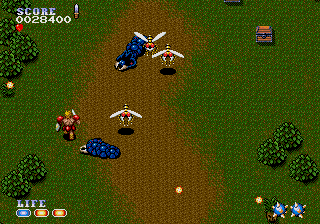 I’ve read many reviews of this game that compare it to Capcom’s arcade classic Commando and while I can see the resemblance, I have to argue that Undead Line has enough substance to stand on its own. The last of the “Forgotten Five,” it was left behind in Japan, depriving American Genesis gamers of an excellent title. It’s pretty straight forward in execution, and the graphics aren’t the best, but the gameplay is tight. The game has a fantasy tone to it rather than going for the typical sci-fi atmosphere of most shmups and this can be seen in everything from the enemies to the power ups, which appear in the form of treasure chests and can be shot to change them into the one you want.
I’ve read many reviews of this game that compare it to Capcom’s arcade classic Commando and while I can see the resemblance, I have to argue that Undead Line has enough substance to stand on its own. The last of the “Forgotten Five,” it was left behind in Japan, depriving American Genesis gamers of an excellent title. It’s pretty straight forward in execution, and the graphics aren’t the best, but the gameplay is tight. The game has a fantasy tone to it rather than going for the typical sci-fi atmosphere of most shmups and this can be seen in everything from the enemies to the power ups, which appear in the form of treasure chests and can be shot to change them into the one you want.
There is definitely reason to own Undead Line and the prices it achieves regularly on eBay are testament to that fact. Having made some progress in completing my Genesis collection (166 games and counting!), I’m planning to tackle the Forgotten Five full steam soon. I already have Panorama Cotton, and this will probably be the next one I go after.
Vapor Trail
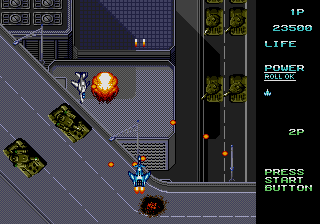 Eight meg power! The thing that stands out most in my mind when I think of Vapor Trail is how much it cost when it first came out. Nowhere in my local area was it sold for less than $69.99, and after playing it, I can’t for the life of me see why this was so. Not that the game is bad or anything, but it simply doesn’t produce the kind of experience that you’d expect from a shmup that expensive, especially when there are cheaper games in the genre that play much better. The two-player mode is nice, and the whole package overall does a good job of emulating the arcade original. Very arcadey and frantic, with some a good weapons system, Vapor Trail becomes much more interesting when you bring a friend along for the ride. Choose from one of three different ships and battle your way through several graphically underwhelming cities. Just don’t get lost in all the bullet mayhem onscreen (as happens in two-player shmups sometimes).
Eight meg power! The thing that stands out most in my mind when I think of Vapor Trail is how much it cost when it first came out. Nowhere in my local area was it sold for less than $69.99, and after playing it, I can’t for the life of me see why this was so. Not that the game is bad or anything, but it simply doesn’t produce the kind of experience that you’d expect from a shmup that expensive, especially when there are cheaper games in the genre that play much better. The two-player mode is nice, and the whole package overall does a good job of emulating the arcade original. Very arcadey and frantic, with some a good weapons system, Vapor Trail becomes much more interesting when you bring a friend along for the ride. Choose from one of three different ships and battle your way through several graphically underwhelming cities. Just don’t get lost in all the bullet mayhem onscreen (as happens in two-player shmups sometimes).
Verytex
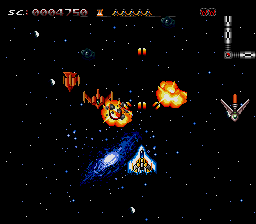 Most people will pass right by Verytex without giving it a second thought, and by doing so, miss one of the better vertical shmups on the Genesis. It reminds me a lot of the Turbo Grafx-16 classic Blazing Lazers, in style and gameplay, and that is a good thing. I can imagine that there will be comparisons to Compile’s masterpiece M.U.S.H.A., but that would be unfair, I think. Verytex plays a lot slower than that game and is less about huge bosses and dodging. I know, you’re thinking but what’s so special about it then? Its simplicity. It never tries to be anything huge and is a better game because of it. Everything is well done, from the graphics to the power ups and difficulty level. You might not be blown away from its intensity, but you will appreciate what a solid shmup it is. This one is relatively unknown to most Genny gamers, and fans of the genre would do well to find a copy and give it a try. I was quick to dismiss it, and now see how wrong I was. It’s a great little game.
Most people will pass right by Verytex without giving it a second thought, and by doing so, miss one of the better vertical shmups on the Genesis. It reminds me a lot of the Turbo Grafx-16 classic Blazing Lazers, in style and gameplay, and that is a good thing. I can imagine that there will be comparisons to Compile’s masterpiece M.U.S.H.A., but that would be unfair, I think. Verytex plays a lot slower than that game and is less about huge bosses and dodging. I know, you’re thinking but what’s so special about it then? Its simplicity. It never tries to be anything huge and is a better game because of it. Everything is well done, from the graphics to the power ups and difficulty level. You might not be blown away from its intensity, but you will appreciate what a solid shmup it is. This one is relatively unknown to most Genny gamers, and fans of the genre would do well to find a copy and give it a try. I was quick to dismiss it, and now see how wrong I was. It’s a great little game.
Xenon 2
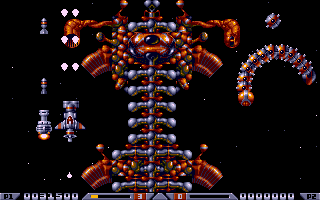 Another Amiga port, this one done by the famous Bitmap Brothers, Xenon 2 definitely has that Euro feel (its graphical style reminds me a lot of the original Turrican). The sound is nothing special, but it’s gameplay that counts, and thankfully Xenon 2 doesn’t falter here. It moves along at an acceptable pace most of the time, except for some slowdown in certain areas. The whole pace of the game is slow for a top-down shmup, and it this can make it seem to drag in places. I’ve never played the original, so I can’t comment on how it compares, but it’s not that bad for what it is, considering the competition it has. Xenon 2 was never released on the Genesis in the U.S., so you’ll have to track down a PAL copy if you’re looking to give it a spin. You won’t be disappointed, but just don’t expect to be blown away.
Another Amiga port, this one done by the famous Bitmap Brothers, Xenon 2 definitely has that Euro feel (its graphical style reminds me a lot of the original Turrican). The sound is nothing special, but it’s gameplay that counts, and thankfully Xenon 2 doesn’t falter here. It moves along at an acceptable pace most of the time, except for some slowdown in certain areas. The whole pace of the game is slow for a top-down shmup, and it this can make it seem to drag in places. I’ve never played the original, so I can’t comment on how it compares, but it’s not that bad for what it is, considering the competition it has. Xenon 2 was never released on the Genesis in the U.S., so you’ll have to track down a PAL copy if you’re looking to give it a spin. You won’t be disappointed, but just don’t expect to be blown away.
Best of the Rest
So, we’ve looked at both vertical and horizontal shmups. What’s left? Plenty, my friend! The Genesis has quite a few games that fit the genre though they don’t scroll in either of the two traditional directions. Many of these use a pseudo-3D engine or scroll every which way left from Sunday. For that reason, we’re giving them a category all their own!
The Afterburner Series
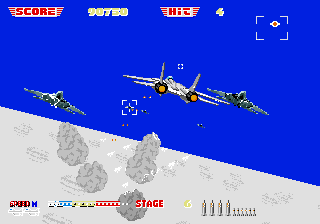 The After Burner games have been on every single Genesis console since the Master system, but Genesis fans were lucky to get all three games. Be it the original for the 32X, the sequel for the Genesis itself, or part three on the Sega CD’ there’s enough arcade action here to satisfy any arcade buff. I personally prefer the 32X After Burner, but both the other games are great as well, even though After Burner III comes up just short of its cartridge siblings. Pretty strange that, given that it should possibly have been the best of the bunch, having the advantage of the Sega CD’s hardware scaling and rotation. That version has an excellent soundtrack though, second in the series only to the remixed tracks on the Sega Ages collection released on the Saturn by Working Designs. Every Genesis fan should have these games in their library; they’re just that much fun. Read our reviews of Afterburner Complete and Afterburner III.
The After Burner games have been on every single Genesis console since the Master system, but Genesis fans were lucky to get all three games. Be it the original for the 32X, the sequel for the Genesis itself, or part three on the Sega CD’ there’s enough arcade action here to satisfy any arcade buff. I personally prefer the 32X After Burner, but both the other games are great as well, even though After Burner III comes up just short of its cartridge siblings. Pretty strange that, given that it should possibly have been the best of the bunch, having the advantage of the Sega CD’s hardware scaling and rotation. That version has an excellent soundtrack though, second in the series only to the remixed tracks on the Sega Ages collection released on the Saturn by Working Designs. Every Genesis fan should have these games in their library; they’re just that much fun. Read our reviews of Afterburner Complete and Afterburner III.
Air Diver
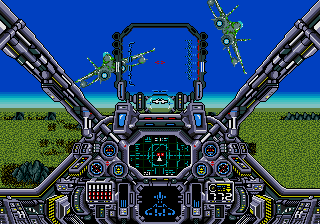 As one of only four games released by the now-defunct publisher Seismic, Air Diver rounds out their trilogy of shmups by filling in the “other” category (M.U.S.H.A. is a vertishmup and Hellfire a horishmup). It’s very much in the same vein as the Afterburner series but has you also fighting extraterrestrials instead of just enemy jets. Hmm, a terrorist organization that has the backing of several unfriendly alien governments? And we thought Bin Laden was bad! Air Diver‘s unique premise makes for some interesting combat, and I found it interesting to discover how the F-119D stealth fighter can hold its own against alien technology. Though not big on graphics, the game does do a good job of emulating the speed of flying a high-speed craft, and it features something that Sega’s jet games lack: boss battles. Taking on big mother ships with your missiles and vulcan cannon may not seem like much of a contest, but never underestimate stealth technology! Maybe this has something to do with all those rumors of it being based on stuff found at Roswell…
As one of only four games released by the now-defunct publisher Seismic, Air Diver rounds out their trilogy of shmups by filling in the “other” category (M.U.S.H.A. is a vertishmup and Hellfire a horishmup). It’s very much in the same vein as the Afterburner series but has you also fighting extraterrestrials instead of just enemy jets. Hmm, a terrorist organization that has the backing of several unfriendly alien governments? And we thought Bin Laden was bad! Air Diver‘s unique premise makes for some interesting combat, and I found it interesting to discover how the F-119D stealth fighter can hold its own against alien technology. Though not big on graphics, the game does do a good job of emulating the speed of flying a high-speed craft, and it features something that Sega’s jet games lack: boss battles. Taking on big mother ships with your missiles and vulcan cannon may not seem like much of a contest, but never underestimate stealth technology! Maybe this has something to do with all those rumors of it being based on stuff found at Roswell…
The Battlemania Series
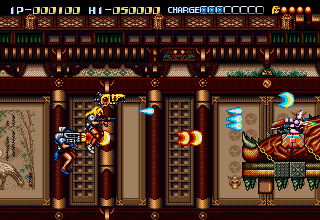 One of the biggest travesties of the Genesis era was the failure to localize Battlemania 2. The original came stateside thanks to the good folks at Vic Tokai under the title Trouble Shooter and even with its horrible artwork (how horrible? Check it out here), it’s still one of my favorites. You take control of a pair of hired guns called Crystal and Madison and set off to rescue Prince Eldon, who has been kidnapped by the evil weapons genius Blackball. The story is hilarious, and the humor never lets up, even during boss battles (Trouble Shooter’s stage one boss blows kisses before he strikes!). Cut scenes are merely a convenient stage for some of the corny gags and comments that you’ll either groan or roll with laughter at. The gameplay is Forgotten Worlds but differs in that you control both Madison and Crystal simultaneously. The game is mostly a horizontal scroller but does move vertically in some cases and the need to use Crystal to shoot behind you is constant.
One of the biggest travesties of the Genesis era was the failure to localize Battlemania 2. The original came stateside thanks to the good folks at Vic Tokai under the title Trouble Shooter and even with its horrible artwork (how horrible? Check it out here), it’s still one of my favorites. You take control of a pair of hired guns called Crystal and Madison and set off to rescue Prince Eldon, who has been kidnapped by the evil weapons genius Blackball. The story is hilarious, and the humor never lets up, even during boss battles (Trouble Shooter’s stage one boss blows kisses before he strikes!). Cut scenes are merely a convenient stage for some of the corny gags and comments that you’ll either groan or roll with laughter at. The gameplay is Forgotten Worlds but differs in that you control both Madison and Crystal simultaneously. The game is mostly a horizontal scroller but does move vertically in some cases and the need to use Crystal to shoot behind you is constant.
Battlemania 2, or Trouble Shooter Vintage as it’s sometimes called, never came to the U.S. and that’s a shame. It goes far beyond the original in so many ways and is really where the series hit its stride. The graphics are amazing (all that parallax!) and the bosses are huge. Gameplay remains mostly intact from the original, but the weapons are even more destructive now. Probably the most expensive of the “Forgotten Five” after Panorama Cotton, this is one of those games that is actually worth its price.
Burning Force
 What’s the best way to describe Burning Force? Simple. Space Harrier on a bike, at half the speed. Everything here seems influenced by Sega’s classic coin-op, only Namco didn’t have the energy to copy the most important aspect of Harrier: the speed and excitement of fast, twitch gameplay. Burning Force plods along, seemingly taking forever to get to the end of a stage, and sometimes the action is slow enough to put you to sleep. The cool warping effect and decent weapons system might be enough to nudge you awake, but you’ll zonk out again as soon as you get to a boss battle. The worse part about this is that the game is quite long and feels like it goes on forever at some points. Adding to the mediocrity is a great soundtrack that is overshadowed by some bad sound effects. I know that arcade ports were usually off the mark back in those days, but this could have been much better.
What’s the best way to describe Burning Force? Simple. Space Harrier on a bike, at half the speed. Everything here seems influenced by Sega’s classic coin-op, only Namco didn’t have the energy to copy the most important aspect of Harrier: the speed and excitement of fast, twitch gameplay. Burning Force plods along, seemingly taking forever to get to the end of a stage, and sometimes the action is slow enough to put you to sleep. The cool warping effect and decent weapons system might be enough to nudge you awake, but you’ll zonk out again as soon as you get to a boss battle. The worse part about this is that the game is quite long and feels like it goes on forever at some points. Adding to the mediocrity is a great soundtrack that is overshadowed by some bad sound effects. I know that arcade ports were usually off the mark back in those days, but this could have been much better.
Darxide
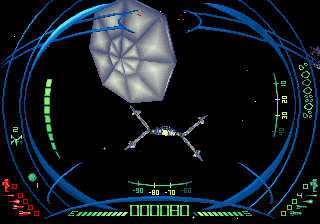 Too little, too late. That would perhaps be the best way to sum up Frontier Developments Ltd.’s Darxide. Available only in Europe, it was the last game to be released there for the 32X (penultimate overall, behind Spider-Man: Web of Fire) before the system was discontinued as part of Sega’s mad scheme to kill off everything to focus on the Saturn (and we all know how well that went). Essentially, Darxide is a modern take on the arcade classic Asteroids. An alien race has displaced an asteroid field, and this is wreaking havoc on the solar system and its miner inhabitants. As the only craft available, you must battle through twelve “levels” to protect the planets of the system from the drifting space rocks, as well as from opposing alien craft. Each of the so-called “levels” themselves are merely your approach to the next planet in the solar system, all of which are crawling with asteroids and alien baddies.
Too little, too late. That would perhaps be the best way to sum up Frontier Developments Ltd.’s Darxide. Available only in Europe, it was the last game to be released there for the 32X (penultimate overall, behind Spider-Man: Web of Fire) before the system was discontinued as part of Sega’s mad scheme to kill off everything to focus on the Saturn (and we all know how well that went). Essentially, Darxide is a modern take on the arcade classic Asteroids. An alien race has displaced an asteroid field, and this is wreaking havoc on the solar system and its miner inhabitants. As the only craft available, you must battle through twelve “levels” to protect the planets of the system from the drifting space rocks, as well as from opposing alien craft. Each of the so-called “levels” themselves are merely your approach to the next planet in the solar system, all of which are crawling with asteroids and alien baddies.
It kills me to look at Darxide and know that Sega let this game stay in Europe. If ever there was a title to show off the 32X’s capabilities and sell systems, this was it. It’s the one of the only 32X titles to use texture mapping (I’ve read that Doom and Metal Head use it as well), and actually looks better than some early Saturn games. Interestingly enough, Frontier has brought Darxide back for Microsoft Mobile Pocket PCs and Nokia’s Series 60 Smartphone in a newly enhanced version entitled Darxide EMP. You do better to get one of those versions, since a complete 32X copy will run you more than the phone itself (some auctions on eBay have reached as high as $300).
Forgotten Worlds
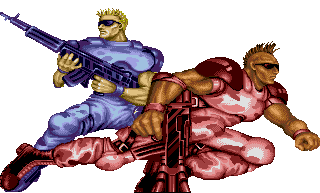 Capcom has quite a few shmups in their catalog and allowed Sega to release one of their better efforts for the Genesis’ debut. Forgotten Worlds puts you in the role of either of the “Nameless Ones” and sends you out across several levels of intense action that sometimes scroll vertically and even diagonally. Along the way you collect Zenny coins for each kill that can be used purchase weapons and items in the store, which springs up at the beginning of each level. A second player can come along for the ride, making this one a good choice for some multi-player shmupping. The graphics are quite good and the game plays surprisingly well with the Genesis pad (A rotates counter-clockwise and B rotates clockwise), especially the very comfortable six-button pad.
Capcom has quite a few shmups in their catalog and allowed Sega to release one of their better efforts for the Genesis’ debut. Forgotten Worlds puts you in the role of either of the “Nameless Ones” and sends you out across several levels of intense action that sometimes scroll vertically and even diagonally. Along the way you collect Zenny coins for each kill that can be used purchase weapons and items in the store, which springs up at the beginning of each level. A second player can come along for the ride, making this one a good choice for some multi-player shmupping. The graphics are quite good and the game plays surprisingly well with the Genesis pad (A rotates counter-clockwise and B rotates clockwise), especially the very comfortable six-button pad.
FACT: Forgotten Worlds was also released for the Turbo Duo. It featured better graphics, all the levels from the arcade, and a great soundtrack but lacked the two-player option and suffered from horrible gameplay with the stock Duo pad. Nec Avenue remedied this by releasing an excellent controller for it in Japan, but U.S. gamers were once again left out in the cold.
I personally prefer the Genesis version, as the gameplay is much better, and the two-player option maintains more of the arcade original’s feel. Not convinced? Read our review and decide for yourself.
G-LOC Air Battle
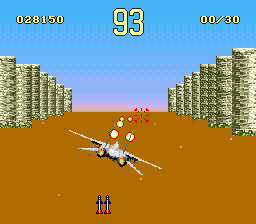 If you think that G-LOC Air Battle is anything like Sega’s other jet fighter classic Afterburner, you’re only half right. Unlike that arcade monster, G-LOC focuses more on single objectives than it does on rip-roaring speed and adrenalin. You’ll be tasked with everything shooting down a specific number of enemy planes to taking out ground forces in canyons. You’ll even find yourself having to land your plane on the aircraft carrier deck! There are different changes in viewpoint, which livens things up a bit (and it’s done much better than the horrible Afterburner III), but the game is much slower than you’d expect, and while the action is solid, it does get repetitive after a while. Nonetheless, Afterburner fans still looking for some more Tomcat fun should definitely check out G-LOC, at least to see how the concept can be taken in a different direction that’s still fun.
If you think that G-LOC Air Battle is anything like Sega’s other jet fighter classic Afterburner, you’re only half right. Unlike that arcade monster, G-LOC focuses more on single objectives than it does on rip-roaring speed and adrenalin. You’ll be tasked with everything shooting down a specific number of enemy planes to taking out ground forces in canyons. You’ll even find yourself having to land your plane on the aircraft carrier deck! There are different changes in viewpoint, which livens things up a bit (and it’s done much better than the horrible Afterburner III), but the game is much slower than you’d expect, and while the action is solid, it does get repetitive after a while. Nonetheless, Afterburner fans still looking for some more Tomcat fun should definitely check out G-LOC, at least to see how the concept can be taken in a different direction that’s still fun.
Galaxy Force II
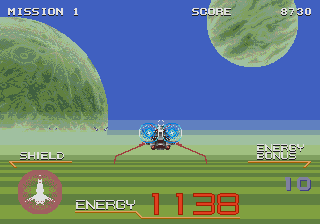 This is perhaps my biggest disappointment on the Genesis. Of all the games that were ported from the arcades, Galaxy Force II was the one to which I was most looking forward. I knew that the Genesis could in no way reproduce the fantastic rotation of Sega’s fantastic Y board coin-op, I at least hoped that the actual gameplay and graphics would make the transition intact. Unfortunately, there is severe sprite flickering and some slowdown, both of which are bad enough to affect gameplay in certain areas. The more I go back and play this, hoping my memory is worse than the reality, the more apparent it becomes that this was a game made for the Sega CD, which could have handled it without much trouble. The Y board is the same used for Power Drift, another arcade classic that had Sega CD written all over it. Ironically enough, Sega chose to let that one come out on PC-Engine HuCard (!) and Galaxy Force got stuck with a rather small cartridge. One of the first of Sega’s many blunders with their CD add-on, as both of these games could have helped to sell systems.
This is perhaps my biggest disappointment on the Genesis. Of all the games that were ported from the arcades, Galaxy Force II was the one to which I was most looking forward. I knew that the Genesis could in no way reproduce the fantastic rotation of Sega’s fantastic Y board coin-op, I at least hoped that the actual gameplay and graphics would make the transition intact. Unfortunately, there is severe sprite flickering and some slowdown, both of which are bad enough to affect gameplay in certain areas. The more I go back and play this, hoping my memory is worse than the reality, the more apparent it becomes that this was a game made for the Sega CD, which could have handled it without much trouble. The Y board is the same used for Power Drift, another arcade classic that had Sega CD written all over it. Ironically enough, Sega chose to let that one come out on PC-Engine HuCard (!) and Galaxy Force got stuck with a rather small cartridge. One of the first of Sega’s many blunders with their CD add-on, as both of these games could have helped to sell systems.
Granada
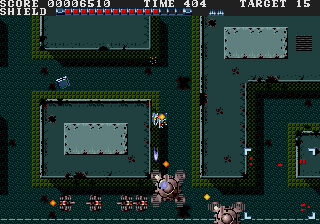 Renovation was always one of the premier third-party companies for the Genesis and they released more titles than just about anyone, save for Electronic Arts and Sega themselves. Among their huge line of contributions was Granada, which still causes controversy to this day. Is it or isn’t a shmup? I feel that it is, since you are piloting a ship while you take out enemies everywhere. The style is different from your standard shmup, but the concept is still the same. You’re placed into a level with no real path to follow, just and objective: kill everything. Two primary and five secondary weapons (depending on the stage) give you all the firepower you need to accomplish your mission. There aren’t that many stages but given the sheer size of them all, you’ll take more time to reach the boss than you would think. While it may not be much to look at graphically, Granada isn’t ugly by any stretch of the imagination. It’s one of those games that has that “early Genesis” feel (take that as you will).
Renovation was always one of the premier third-party companies for the Genesis and they released more titles than just about anyone, save for Electronic Arts and Sega themselves. Among their huge line of contributions was Granada, which still causes controversy to this day. Is it or isn’t a shmup? I feel that it is, since you are piloting a ship while you take out enemies everywhere. The style is different from your standard shmup, but the concept is still the same. You’re placed into a level with no real path to follow, just and objective: kill everything. Two primary and five secondary weapons (depending on the stage) give you all the firepower you need to accomplish your mission. There aren’t that many stages but given the sheer size of them all, you’ll take more time to reach the boss than you would think. While it may not be much to look at graphically, Granada isn’t ugly by any stretch of the imagination. It’s one of those games that has that “early Genesis” feel (take that as you will).
FACT: Granada is often mistakenly referred to as Granada “X” due to the style of the logo.
Kolibri
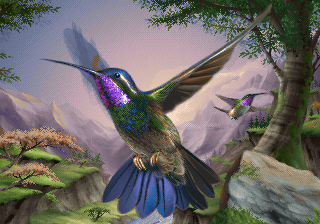 Very odd, but very original, Kolibri is the type of game that tries to break the established conventions of a genre by injecting some originality into the gameplay, while innovating graphically. You play one mean little hummingbird charged with saving the environment from a dark crystal that is destroying everything. Leave it to developer Novatrade (of Ecco the Dolphin fame) to go way beyond what you’d expect from a shmup. It may seem weird to use a laser-wielding, bomb-dropping, little bird against a slew of insects and other animal nasties, but it’s actually a lot of fun. The game looks absolutely gorgeous, with some of the most colorful backgrounds you’ll see on either the Genesis or 32X. As with Ecco, the presentation tries to be peaceful, something odd for a shmup. There’s no emphasis on hectic action here; exploration is instead the focus of each level, and sometimes it can be a bit hard to even find your way through to the end of the level.
Very odd, but very original, Kolibri is the type of game that tries to break the established conventions of a genre by injecting some originality into the gameplay, while innovating graphically. You play one mean little hummingbird charged with saving the environment from a dark crystal that is destroying everything. Leave it to developer Novatrade (of Ecco the Dolphin fame) to go way beyond what you’d expect from a shmup. It may seem weird to use a laser-wielding, bomb-dropping, little bird against a slew of insects and other animal nasties, but it’s actually a lot of fun. The game looks absolutely gorgeous, with some of the most colorful backgrounds you’ll see on either the Genesis or 32X. As with Ecco, the presentation tries to be peaceful, something odd for a shmup. There’s no emphasis on hectic action here; exploration is instead the focus of each level, and sometimes it can be a bit hard to even find your way through to the end of the level.
Not your typical shmup, Kolibri deserves a look, regardless. Yet another good reason for shmup fans to think about getting a 32X.
Night Striker
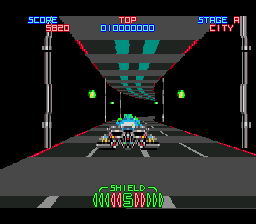 Yet another great Sega CD games left to rot in Japan due to Sega’s insane belief that the natural evolution was FMV games (ask Digital Pictures how that turned out), Night Striker is a game that seems to be made for the system. Taking the classic forward-scrolling gameplay of Super Thunder Blade and Galaxy Force II and using the Sega CD’s hardware scaling features, it plays much smoother than those games, and looks great. You play through six levels out of a possible nine (think of a Darius-style set up), which makes it highly replayable…and playing it is very simple. The entire game is already in English, and all you need is to pick up the controller and get going. Shoot and dodge are the only instructions you’ll need to jump right in. I found Night Striker to be somewhat influenced by Space Harrier in regard to enemies and bosses, which isn’t a bad thing at all, and I get a little sad when I think that it, along with so many others, weren’t brought to the U.S. The Sega CD really could have benefited from more games like it. You can always import though, or go for the Saturn version, which both looks better and is easier to play on a U.S. system.
Yet another great Sega CD games left to rot in Japan due to Sega’s insane belief that the natural evolution was FMV games (ask Digital Pictures how that turned out), Night Striker is a game that seems to be made for the system. Taking the classic forward-scrolling gameplay of Super Thunder Blade and Galaxy Force II and using the Sega CD’s hardware scaling features, it plays much smoother than those games, and looks great. You play through six levels out of a possible nine (think of a Darius-style set up), which makes it highly replayable…and playing it is very simple. The entire game is already in English, and all you need is to pick up the controller and get going. Shoot and dodge are the only instructions you’ll need to jump right in. I found Night Striker to be somewhat influenced by Space Harrier in regard to enemies and bosses, which isn’t a bad thing at all, and I get a little sad when I think that it, along with so many others, weren’t brought to the U.S. The Sega CD really could have benefited from more games like it. You can always import though, or go for the Saturn version, which both looks better and is easier to play on a U.S. system.
Panorama Cotton
Success created a game that pushed the Genesis to its limits, testing its sprite scaling capabilities more than most any other game. Sunsoft published it and only made around 5,000 copies. The game, Panorama Cotton is the series’ only entry on the console and it commands upwards of $100 on eBay, making it the most expensive of the “Forgotten Five” and one of the priciest games on the system. I scored my copy for $150 and love it, as the game does everything Space Harrier 2 did, only in much grander fashion. It’s long and deep, with plenty to come back to once you’re done.
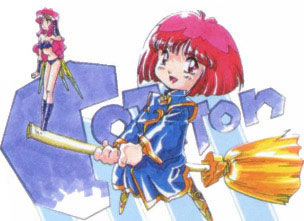 The magic upgrade system allows for some awesome attacks, giving you some excellent offensive options. I think our review says it best: Enemies release little floating scrolls that are what give you your magic attacks. Each color represents a different magic, and you can change the type of magic in each scroll by shooting them before you take them. You need to fly close to them or they’ll zip right past you. That presents an interesting challenge as you’re also shooting enemies and avoiding oncoming fire.
The magic upgrade system allows for some awesome attacks, giving you some excellent offensive options. I think our review says it best: Enemies release little floating scrolls that are what give you your magic attacks. Each color represents a different magic, and you can change the type of magic in each scroll by shooting them before you take them. You need to fly close to them or they’ll zip right past you. That presents an interesting challenge as you’re also shooting enemies and avoiding oncoming fire.
As you rack up kills, an experience meter fills up. Each time it fills, your magic goes up a level, giving it a longer range and making it more potent. Also, collecting little star orbs can increase your total life bar, which is indispensable for getting through the long stages.
I recommend you find yourself a copy and see just why Panorama Cotton is so revered. You may want to try it out first (hint, hint), but I’m sure you’ll agree that it’s worth having in your library.
FACT: Upon release, Success gave away a limited-edition teacup (see it here) as a promotional item during the ETCS Show back in 1995. Don’t expect to find that teacup though, as it’s practically non-existent nowadays.
Shadow Squadron
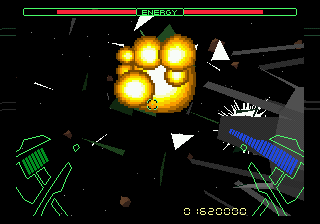 I don’t care what anyone says. I personally liked Shadow Squadron more than Star Wars Arcade. It brought back memories of playing Star Raiders on the Atari 2600, and any game that can do that deserves a place in this guide. Known as Stellar Assault in Europe, Shadow Squadron is a fun little shmup that plays better than the aforementioned LucasArts title. It’s best when used with the 6-button controller, with a total of five used for different commands. There are several objectives that must be completed to pass each stage, and this is where Shadow Squadron shines. You can choose auto pilot and concentrate on blowing things up or take a friend and let him fly while you blast everything in sight! Not as hard as Star Wars Arcade, it can be beaten fairly quickly, but is fun enough to come back to. It’s inexpensive, enjoyable, and good with a pal. Hey, you need every reason you can find for owning a 32X. Here’s one more.
I don’t care what anyone says. I personally liked Shadow Squadron more than Star Wars Arcade. It brought back memories of playing Star Raiders on the Atari 2600, and any game that can do that deserves a place in this guide. Known as Stellar Assault in Europe, Shadow Squadron is a fun little shmup that plays better than the aforementioned LucasArts title. It’s best when used with the 6-button controller, with a total of five used for different commands. There are several objectives that must be completed to pass each stage, and this is where Shadow Squadron shines. You can choose auto pilot and concentrate on blowing things up or take a friend and let him fly while you blast everything in sight! Not as hard as Star Wars Arcade, it can be beaten fairly quickly, but is fun enough to come back to. It’s inexpensive, enjoyable, and good with a pal. Hey, you need every reason you can find for owning a 32X. Here’s one more.
Soul Star
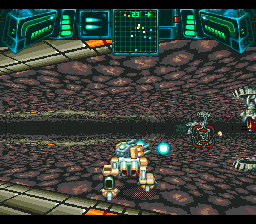 Soul Star is one of my favorite Sega CD games, and one of Core’s best efforts overall, I think. It is the epitome of everything a Sega CD shmup should be, in terms of presentation. Some amazing scaling and rotation show off what the system can do, and the soundtrack is absolutely incredible. Now, all this goodness has to have a price, right? Well, yes and no. If anything can be mentioned, it would have to be the game’s insane difficulty level. Soul Star can be brutally hard, sometimes practically cheap. This is due to the steep learning curve of its gameplay. I recommend you have a six-button pad, as playing Soul Star with the stock pad is nigh impossible. Those with zen-like patience and a mean streak should have no trouble, but the rest of us are in for a really hard time. As one of the few shmups that have no codes, no debugs, no hidden easter eggs or anything; it is truly a man’s shmup.
Soul Star is one of my favorite Sega CD games, and one of Core’s best efforts overall, I think. It is the epitome of everything a Sega CD shmup should be, in terms of presentation. Some amazing scaling and rotation show off what the system can do, and the soundtrack is absolutely incredible. Now, all this goodness has to have a price, right? Well, yes and no. If anything can be mentioned, it would have to be the game’s insane difficulty level. Soul Star can be brutally hard, sometimes practically cheap. This is due to the steep learning curve of its gameplay. I recommend you have a six-button pad, as playing Soul Star with the stock pad is nigh impossible. Those with zen-like patience and a mean streak should have no trouble, but the rest of us are in for a really hard time. As one of the few shmups that have no codes, no debugs, no hidden easter eggs or anything; it is truly a man’s shmup.
The Space Harrier Series
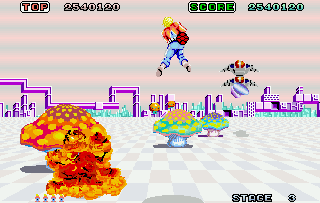 Until the release of Sega Ages on the Saturn (and later Shenmue 1 & 2), the 32X version of Space Harrier was the best one available and the closest to being arcade perfect. Sega’s classic shmup is famous for its frantic pace and twitch gameplay, and all of this is intact here. The graphics are better than any other rendition (surprise!), and it plays as smooth as butter with the wonderful Genesis D pad. True, when I want to play Space Harrier today, I whip out my Saturn Mission Stick and my copy of Sega Ages, but the 32X is a great alternative for those poor souls who don’t have Sega’s 32-bit machine. The 32X’s meager sound chip doesn’t exactly do Space Harrier’s unforgettable soundtrack justice, but I suppose it’s forgivable. This was the type of game the 32X needed, but Sega of Japan was in a corporate daze. It took them another two generations to realize that pretty 3D graphics aren’t enough for a game to be successful. Gameplay is what counts, and Space Harrier has that in spades. That’s the reason it’s a classic, and that’s why it’s been released so many times, most recently on the Sega Classics Collection.
Until the release of Sega Ages on the Saturn (and later Shenmue 1 & 2), the 32X version of Space Harrier was the best one available and the closest to being arcade perfect. Sega’s classic shmup is famous for its frantic pace and twitch gameplay, and all of this is intact here. The graphics are better than any other rendition (surprise!), and it plays as smooth as butter with the wonderful Genesis D pad. True, when I want to play Space Harrier today, I whip out my Saturn Mission Stick and my copy of Sega Ages, but the 32X is a great alternative for those poor souls who don’t have Sega’s 32-bit machine. The 32X’s meager sound chip doesn’t exactly do Space Harrier’s unforgettable soundtrack justice, but I suppose it’s forgivable. This was the type of game the 32X needed, but Sega of Japan was in a corporate daze. It took them another two generations to realize that pretty 3D graphics aren’t enough for a game to be successful. Gameplay is what counts, and Space Harrier has that in spades. That’s the reason it’s a classic, and that’s why it’s been released so many times, most recently on the Sega Classics Collection.
After the incredible game that was the original Space Harrier, it would seem that Sega would be hard pressed to come up with a sequel that could uphold that standard. Some might say that Space Harrier II comes up short, but I would have to disagree. Yes, it’s not as long as the original. Yes, it’s also easier. Does that make it a bad game? Hardly. The sequel stays true to the original formula and goes a step further by adding boss battles at the end of each stage. The scrolling is pretty smooth for a Genesis launch title, and no one would ever think by looking at it that the system could only display 64 colors onscreen at one time.
FACT: Even though the original was ported to just about every console under the sun, no other systems got Space Harrier II except the Commodore 64 and the Sinclair ZX Spectrum.
Space Invaders ’91
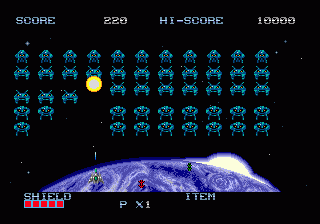 Timeless. That’s about as good a word as any to describe Space Invaders. Along with other arcade icons, like Pong and Pac-Man, it always manages to find its way back into arcades and homes. Just about every console ever made got a port of it in some fashion, and the Genesis received a version of the updated arcade game, which sported new aliens, power ups (speed boost, finally!), and even scrolling backgrounds; all the while maintaining the tried-and-true gameplay of the original. You also have a shield, which helps against the new boss battles that have been added. The gameplay has been refined, and your ship now has a much faster rate of fire, which makes all the difference in the world. Set against some cool backdrops, Space Invaders ’91 is a great little game for when you need a change of pace. Be sure to snatch a copy up quickly though; its price on eBay is increasing at a steady rate and it’ll soon be among the more expensive shmups to find.
Timeless. That’s about as good a word as any to describe Space Invaders. Along with other arcade icons, like Pong and Pac-Man, it always manages to find its way back into arcades and homes. Just about every console ever made got a port of it in some fashion, and the Genesis received a version of the updated arcade game, which sported new aliens, power ups (speed boost, finally!), and even scrolling backgrounds; all the while maintaining the tried-and-true gameplay of the original. You also have a shield, which helps against the new boss battles that have been added. The gameplay has been refined, and your ship now has a much faster rate of fire, which makes all the difference in the world. Set against some cool backdrops, Space Invaders ’91 is a great little game for when you need a change of pace. Be sure to snatch a copy up quickly though; its price on eBay is increasing at a steady rate and it’ll soon be among the more expensive shmups to find.
Super Thunderblade
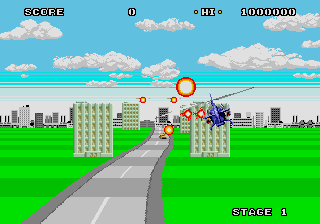 Here we go! One of the first shmups available on the Genesis and based on the awesome (for the time) arcade game, Super Thunder Blade is a sequel to the coin op that made an appearance on the Sega Master System. It tries to improve on the original, but the graphical upgrades done to the scaling make the gameplay less fluid and as hard on the eyes as Sega’s 8-bit machine ever could. Moreover, it’s a bit on the short side, and there’s little fun to be had here, and I guarantee you’ll be pulling your hair on level five. The night city stage was simply a bit too much for the Genesis to handle so early in its life span, and those darn bars that cross the screen aren’t really visible until they’re practically on top of you. Luckily, your chopper is somewhat maneuverable. A decent soundtrack and some boss battles that never capitalized on their full potential round out the package, making this a questionable purchase for shmup fans. Even so, I really think it’s time this series made a comeback, even if it were on a second volume of Sega Arcade Classics. Please Sega, listen to the fans for once!
Here we go! One of the first shmups available on the Genesis and based on the awesome (for the time) arcade game, Super Thunder Blade is a sequel to the coin op that made an appearance on the Sega Master System. It tries to improve on the original, but the graphical upgrades done to the scaling make the gameplay less fluid and as hard on the eyes as Sega’s 8-bit machine ever could. Moreover, it’s a bit on the short side, and there’s little fun to be had here, and I guarantee you’ll be pulling your hair on level five. The night city stage was simply a bit too much for the Genesis to handle so early in its life span, and those darn bars that cross the screen aren’t really visible until they’re practically on top of you. Luckily, your chopper is somewhat maneuverable. A decent soundtrack and some boss battles that never capitalized on their full potential round out the package, making this a questionable purchase for shmup fans. Even so, I really think it’s time this series made a comeback, even if it were on a second volume of Sega Arcade Classics. Please Sega, listen to the fans for once!
Star Wars Arcade
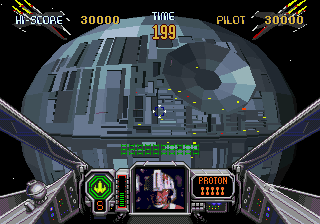 Probably the best reason to own a 32X (yes, there actually are a couple), Star Wars Arcade was the game that single handedly saved Sega in Christmas 1995, keeping Nintendo’s Donkey Kong Country from running away with the market. A port of the great Model 1 arcade game, it brought the best battle of the trilogy to the small screen in a way not seen since the original Star Wars: The Arcade Game had done so over a decade before. Sega improved on the original by adding a special 32X mode, which extended the game by an additional four levels. I personally hate timed levels, and it can sometimes be a pain to have your time run out when you only need one or two more TIEs to kill. It may not be as attractive today as it was back in ’95, but the gameplay is still there, and it’s still fun to play. It’s also incredibly common, and you can practically get a copy just by asking for one.
Probably the best reason to own a 32X (yes, there actually are a couple), Star Wars Arcade was the game that single handedly saved Sega in Christmas 1995, keeping Nintendo’s Donkey Kong Country from running away with the market. A port of the great Model 1 arcade game, it brought the best battle of the trilogy to the small screen in a way not seen since the original Star Wars: The Arcade Game had done so over a decade before. Sega improved on the original by adding a special 32X mode, which extended the game by an additional four levels. I personally hate timed levels, and it can sometimes be a pain to have your time run out when you only need one or two more TIEs to kill. It may not be as attractive today as it was back in ’95, but the gameplay is still there, and it’s still fun to play. It’s also incredibly common, and you can practically get a copy just by asking for one.
Sub-Terrania
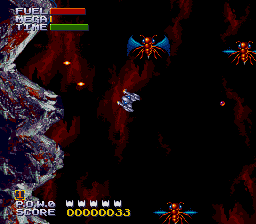 I have mixed feelings writing about this one. Sub-Terrania is one of those games you love to hate. The steep learning curve will shy away all but the most dedicated gamers but once you learn how to navigate your craft, the game isn’t so bad. Fighting gravity might not be something everyone wants to do but it changes the whole shmup dynamic dramatically. Unfortunately, it doesn’t always change it for the better. Navigating through narrow openings can be a pain and the lack of a decent HUD (where’s my shield?) can lead to many bouts of “why did I just die?”
I have mixed feelings writing about this one. Sub-Terrania is one of those games you love to hate. The steep learning curve will shy away all but the most dedicated gamers but once you learn how to navigate your craft, the game isn’t so bad. Fighting gravity might not be something everyone wants to do but it changes the whole shmup dynamic dramatically. Unfortunately, it doesn’t always change it for the better. Navigating through narrow openings can be a pain and the lack of a decent HUD (where’s my shield?) can lead to many bouts of “why did I just die?”
The whole concept of rescuing humans and maintaining your fuel supply is cool enough (the story cut scenes are excellent) but the overbearing gameplay gets in the way far too much. It’s sad really, as I honestly wanted to like Sub-Terrania. Read the review.
Twinkle Tale
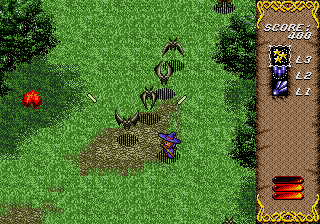 If you can say that Undead Line plays like Commando, then that has to go double for Twinkle Tale. It starts out playing like a vertical shmup and then allows you to walk freely horizontally! Levels stretch out in all directions and while you follow a set path, you can maneuver all over the screen. Some, like stage three, are somewhat interactive (you walk on a cliff from which you can fall, losing a bar of energy). I was initially taken in by its easy-to-learn gameplay and soon found that although it has nothing really innovative about it, it was a joy to play. The single life you’re given adds some challenge and there are several weapons to choose from (including a neat homing shot). Decent graphics and sound may not sound like much at first look but give it a chance and it’ll grow on you. I’m currently searching for a copy and hopefully I’ll be able to get one without having to pawn a kidney.
If you can say that Undead Line plays like Commando, then that has to go double for Twinkle Tale. It starts out playing like a vertical shmup and then allows you to walk freely horizontally! Levels stretch out in all directions and while you follow a set path, you can maneuver all over the screen. Some, like stage three, are somewhat interactive (you walk on a cliff from which you can fall, losing a bar of energy). I was initially taken in by its easy-to-learn gameplay and soon found that although it has nothing really innovative about it, it was a joy to play. The single life you’re given adds some challenge and there are several weapons to choose from (including a neat homing shot). Decent graphics and sound may not sound like much at first look but give it a chance and it’ll grow on you. I’m currently searching for a copy and hopefully I’ll be able to get one without having to pawn a kidney.
Viewpoint
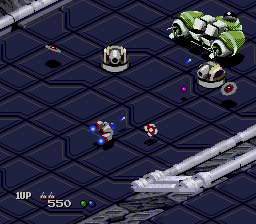 SNK’s Viewpoint pays homage to the classic Sega arcade game Zaxxon by using the same perspective. The gameplay, however, is quite different. It was originally released in arcades on the powerful MVS Neo Geo hardware, and this port is obviously scaled down to fit on the Genesis. The only problem is that it’s still more than the hardware can handle in some instances, and the amount of slowdown that plagues it can hamper the gameplay significantly. It fares much better than the SNES version (blech!) and is still playable.
SNK’s Viewpoint pays homage to the classic Sega arcade game Zaxxon by using the same perspective. The gameplay, however, is quite different. It was originally released in arcades on the powerful MVS Neo Geo hardware, and this port is obviously scaled down to fit on the Genesis. The only problem is that it’s still more than the hardware can handle in some instances, and the amount of slowdown that plagues it can hamper the gameplay significantly. It fares much better than the SNES version (blech!) and is still playable.
The inhabitants of an alien world plan to wipe out all life on Earth (big surprise) and you are our only hope! Your ship has a charge beam in addition to its standard shot, and it can hold up to three different bomb power ups, which you will definitely need. This game is HARD, and the slowdown doesn’t help, like it should. The high point here is how well Viewpoint looks in s-video. Everything is crystal clear and sharper than virtually anything I’ve seen on the system. Too bad the gameplay isn’t as good.
Zaxxon Motherbase 2000
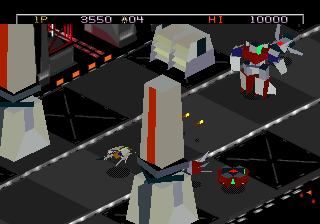 When I think of Zaxxon, I think of how badly I want another sequel. Motherbase 2000 was a great answer to my prayers, albeit one on the wrong platform. Flat-shaded polygons may have been something to marvel at in 1995, but like Silpheed, they haven’t aged all that well. The 32X’s sound chip doesn’t help matters much but the sound isn’t as bad as in some other games on the system. Honestly, I’d be happy if someone took this game and rereleased it as part of a collection (toss in the original Zaxxon while you’re at it), and that would give gamers a chance to see how cool it really is. The coin-op classic’s great gameplay has been updated with some nifty features, like being able to “hack” an enemy ship and use it against its own forces. Many people weren’t aware of this little detail and promptly dismissed Zaxxon as more fodder on an already doomed console. When you take advantage of the hacking dynamic, the game really is a blast to play. Everything, even the plot, is straight forward. If you’re looking for another title for your minuscule 32X collection, give Zaxxon’s Motherbase 2000 a try.
When I think of Zaxxon, I think of how badly I want another sequel. Motherbase 2000 was a great answer to my prayers, albeit one on the wrong platform. Flat-shaded polygons may have been something to marvel at in 1995, but like Silpheed, they haven’t aged all that well. The 32X’s sound chip doesn’t help matters much but the sound isn’t as bad as in some other games on the system. Honestly, I’d be happy if someone took this game and rereleased it as part of a collection (toss in the original Zaxxon while you’re at it), and that would give gamers a chance to see how cool it really is. The coin-op classic’s great gameplay has been updated with some nifty features, like being able to “hack” an enemy ship and use it against its own forces. Many people weren’t aware of this little detail and promptly dismissed Zaxxon as more fodder on an already doomed console. When you take advantage of the hacking dynamic, the game really is a blast to play. Everything, even the plot, is straight forward. If you’re looking for another title for your minuscule 32X collection, give Zaxxon’s Motherbase 2000 a try.
Too many Shmups!
So there you have it, every shmup ever made for the Genesis, Sega CD, and 32X. All of these systems are just laden with quality shmups and every person who’s a fan of the genre should check out. Some of the Japanese games go for much more but are also worthy purchases. Whichever type you prefer: horizontal, vertical, or otherwise, there’s something here for everyone.

Recent Comments